QuickLinks:
800, 801, 802, 803, 804, 805, 806, 807, 808, 809, 810, 811, 812, 813, 814, 815, 816,
817, 818, 819, 820, 821, 822, 823, 824, 825, 826, 827, 828, 829, 830, 831, 832, 833,
834, 835, 836, 837, 838, 839, 840, 841, 842, 843, 844, 845, 846, 847, 848, 849
Page last updated Dec 27, 2017
Checked Corwin positions, original NGC entries, updated to current formatting, added basic pix/etc
Next: Check against most recently updated Steinicke databases
NGC 800 = (PGC 7740)
Discovered (Oct 9, 1885) by Lewis Swift
Also observed (date?) by Herbert Howe
A 13th-magnitude spiral galaxy (type SA(rs)c?) in Cetus (RA 02 02 11.8, Dec -00 07 50)
Historical Identification: Per Dreyer, NGC 800 (Swift list II (#17), 1860 RA 01 55 33, NPD 90 48.3) is "most extremely faint, pretty small, round, southern of 2", the other being NGC 799. The second Index Catalog lists a corrected 1860 RA (per Howe) of 01 55 92.
Physical Information: Paired with NGC 799. Based on a recessional velocity of 5965 km/sec, NGC 800 is about 275 to 280 million light years away. Given that and its apparent size of 1.3 by 0.85 arcmin (including its fainter outer regions), it is about 100 to 105 thousand light years across.
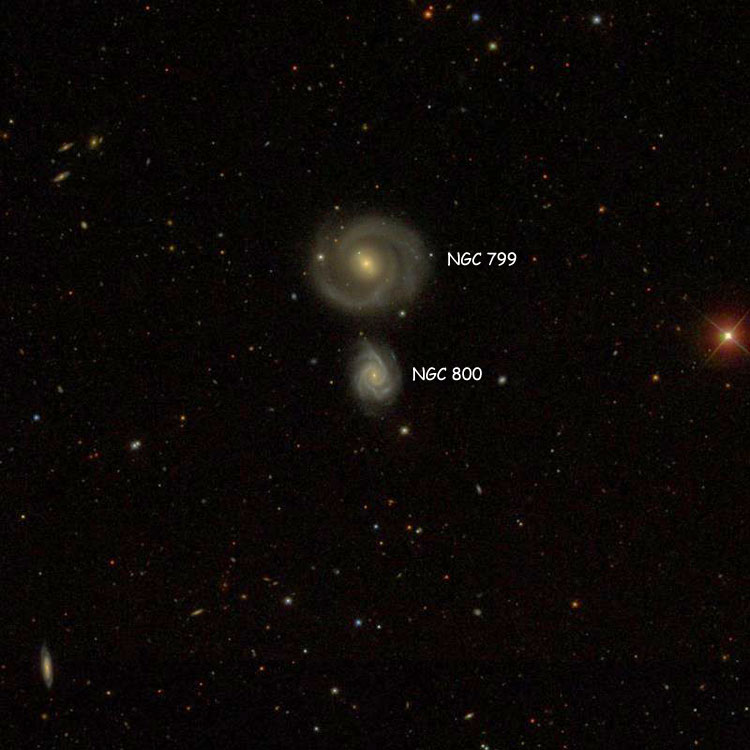
Above, a 12 arcmin wide SDSS image centered on NGC 800, also showing NGC 799
Below, a 1.6 arcmin wide SDSS image of the galaxy

NGC 801 (= PGC 7847)
Discovered (Sep 20, 1885) by Lewis Swift
A 13th-magnitude spiral galaxy (type Sc?) in Andromeda (RA 02 03 44.8, Dec +38 15 32)
Historical Identification: Per Dreyer, NGC 801 (Swift list II (#18), 1860 RA 01 55 40, NPD 52 24.1) is "extremely faint, pretty small, irregularly round, double star close to east".
Physical Information: Apparent size 3.1 by 0.7 arcmin?
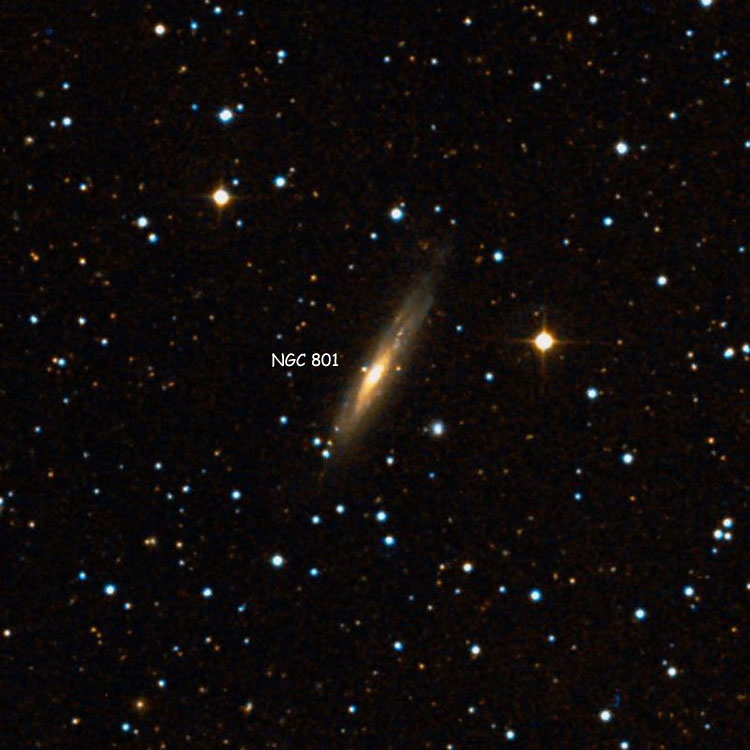
Above, a 12 arcmin wide DSS image centered on NGC 801
Below, a 3.6 arcmin wide DSS image of the galaxy
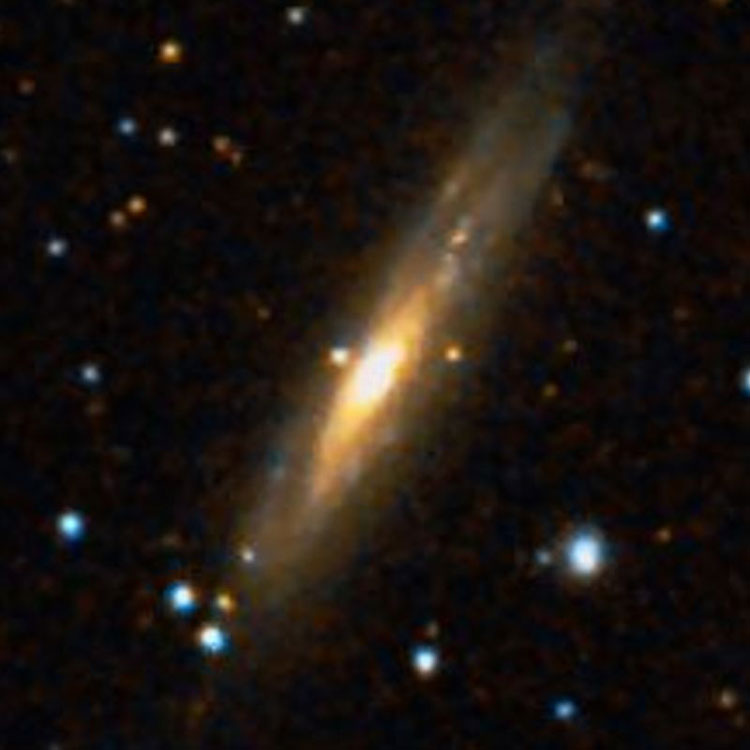
NGC 802 (= PGC 7505)
Discovered (Nov 2, 1834) by John Herschel
A 13th-magnitude lenticular galaxy (type SB0/a?) in Hydrus (RA 01 59 06.0, Dec -67 52 13)
Historical Identification: Per Dreyer, NGC 802 (= GC 482 = JH 2457, 1860 RA 01 55 46, NPD 158 32.7) is "most extremely faint, very small, round, 13th magnitude star 100 arcsec to west".
Physical Information: Apparent size 0.85 by 0.55 arcmin (from images below).

Above, a 12 arcmin wide DSS image centered on NGC 802
Below, a 1 arcmin wide DSS image of the galaxy
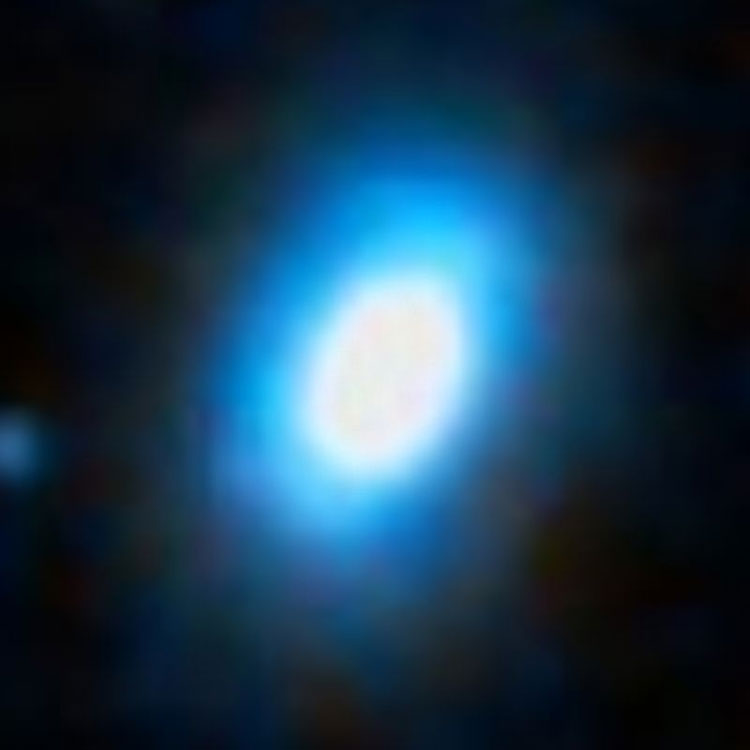
Below, the 12 arcmin wide image at top, also showing a label for PGC 7530

NGC 803 (= PGC 7849)
Discovered (Oct 15, 1784) by William Herschel
Also observed (date?) by John Herschel
A 13th-magnitude spiral galaxy (type Sc?) in Aries (RA 02 03 44.7, Dec +16 01 52)
Historical Identification: Per Dreyer, NGC 803 (= GC 483 = JH 190 = WH III 208, 1860 RA 01 56 08, NPD 74 39.0) is "very faint, small, irregularly round, gradually a little bighter middle, 10th magnitude star 3.5 seconds of time to west".
Physical Information: Apparent size 3.0 by 1.3 arcmin?
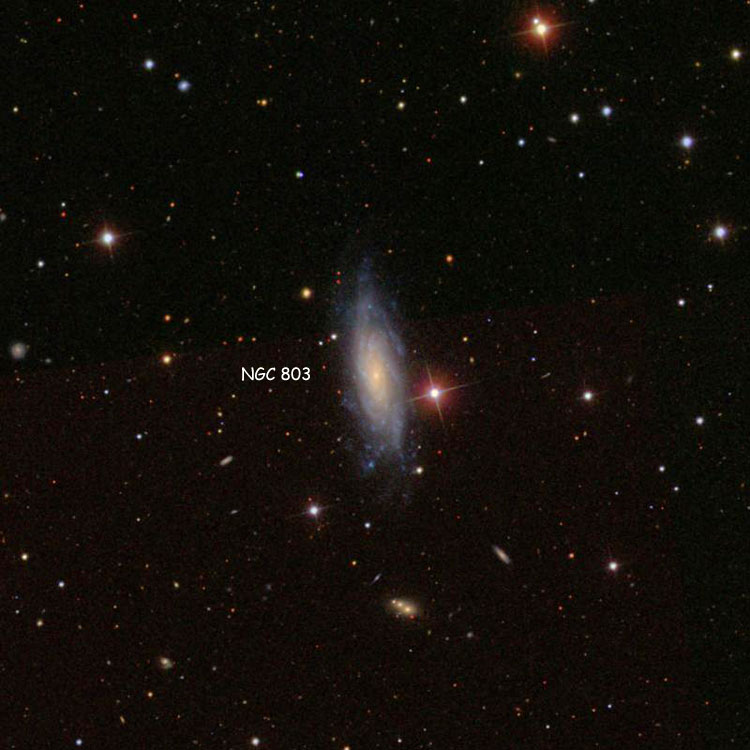
Above, a 12 arcmin wide SDSS image centered on NGC 803
Below, a 3.6 arcmin wide SDSS image of the galaxy
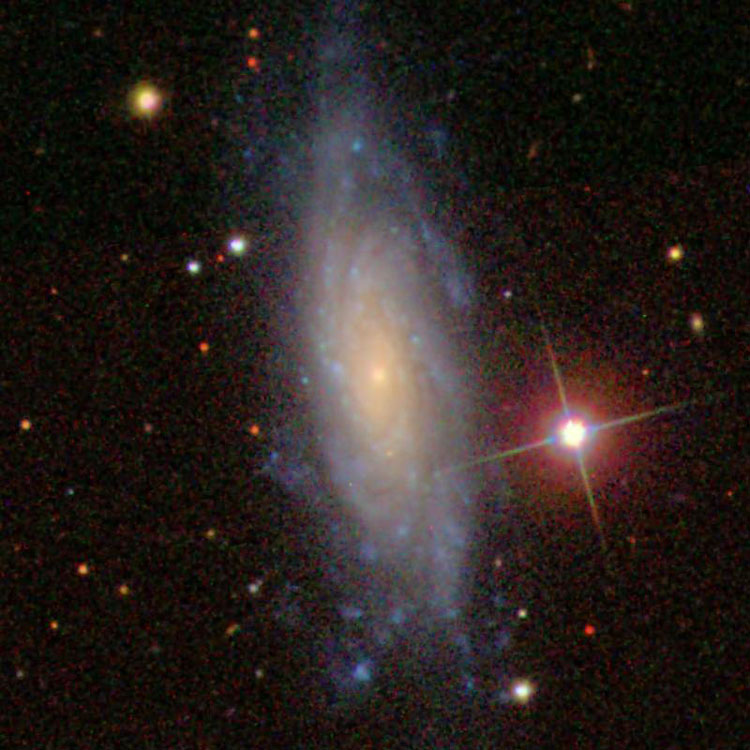
NGC 804 (= IC 1773 = PGC 7873)
Discovered (Sep 7, 1885) by Lewis Swift (and later listed as NGC 804)
Discovered (Dec 24, 1897) by Guillaume Bigourdan (and later listed as IC 1773)
A 14th-magnitude lenticular galaxy (type S0?) in Triangulum (RA 02 04 02.1, Dec +30 49 58)
Historical Identification: Per Dreyer, NGC 804 (Swift list II (#19), 1860 RA 01 56 19, NPD 59 51.0) is "most extremely faint, very small, round, a little brighter middle".
Physical Information: Apparent size 1.0 by 0.35 arcmin (from images below).

Above, a 12 arcmin wide SDSS image centered on NGC 804
Below, a 1.4 arcmin wide SDSS image of the galaxy
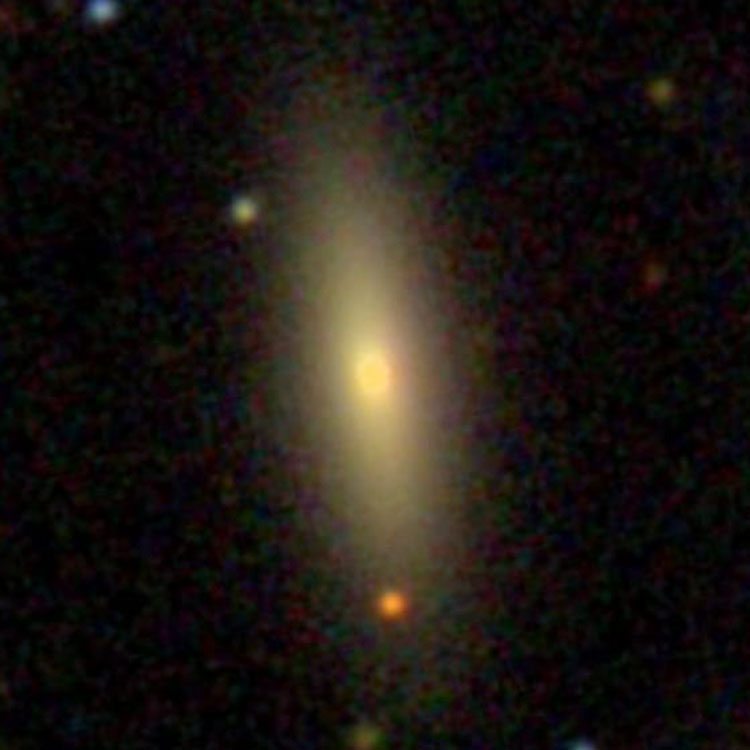
NGC 805 (= PGC 7899)
Discovered (Sep 26, 1864) by Heinrich d'Arrest
A 14th-magnitude lenticular galaxy (type SB0(rs)a?) in Triangulum (RA 02 04 29.6, Dec +28 48 44)
Historical Identification: Per Dreyer, NGC 805 (= GC 5212, d'Arrest, 1860 RA 01 56 29, NPD 61 52.2) is "extremely faint, extremely small, round, two 14th magnitude stars to west".
Physical Information: Apparent size 1.0 by 0.6 arcmin (from images below).

Above, a 12 arcmin wide SDSS image centered on NGC 805
Below, a 1.4 arcmin wide SDSS image of the galaxy
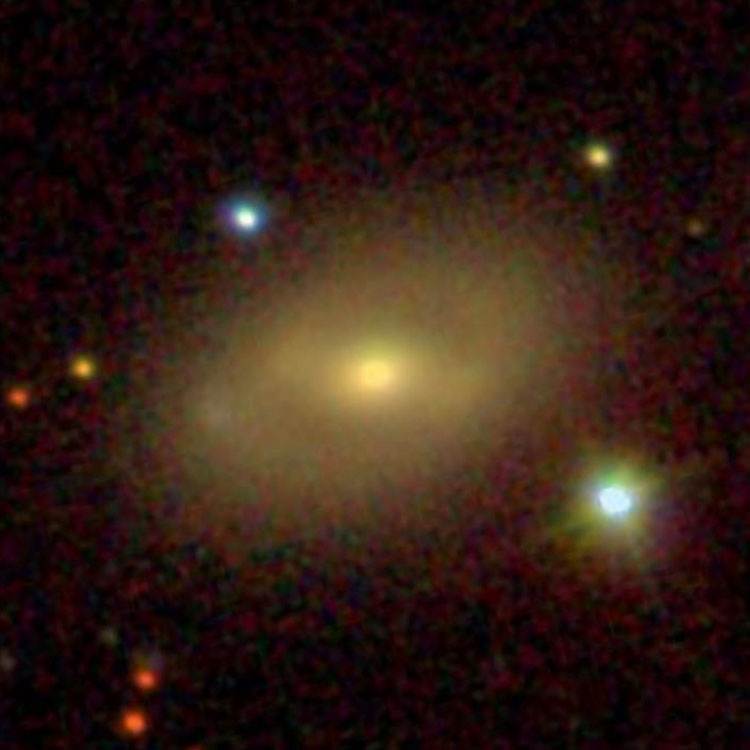
NGC 806 (= PGC 7835 + PGC 3100716)
Discovered (Nov 1, 1886) by Lewis Swift
A pair of interacting galaxies in Cetus
PGC 7835 = A 14th-magnitude spiral galaxy (type Sc? pec) at RA 02 03 31.2, Dec -09 56 00
PGC 3100716 = A 15th-magnitude spiral galaxy (type S? pec) at RA 02 03 32.4, Dec -09 55 46
Historical Identification: Per Dreyer, NGC 806 (Swift list V (#19), 1860 RA 01 56 51, NPD 100 36.1) is "most extremely faint, small, round, very difficult, pretty bright star to north".
Physical Information: Apparent size of PGC 7835 = 1.2 by 0.4 arcmin; of PGC 3100716 = 0.4 by 0.2 arcmin. There is little doubt that the two objects are either colliding galaxies, or the result of a collision.
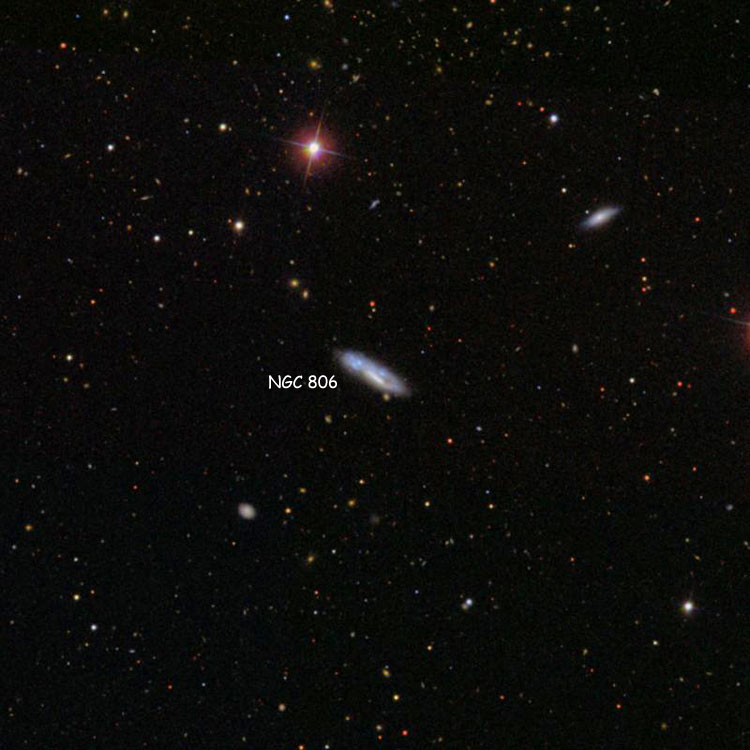
Above, a 12 arcmin wide SDSS image centered on NGC 806
Below, a 2.4 arcmin wide SDSS image of the interacting pair of galaxies
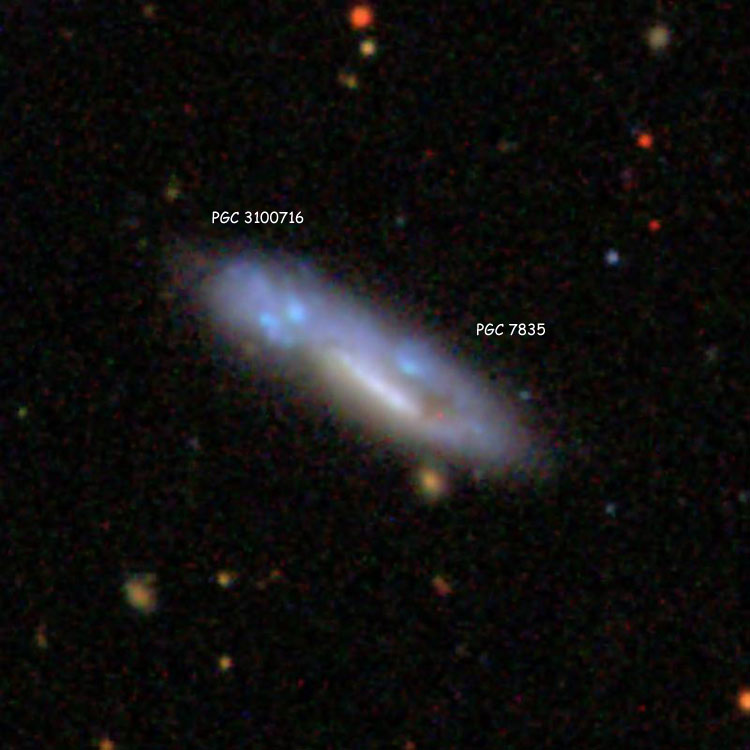
NGC 807 (= PGC 7934)
Discovered (Sep 11, 1784) by William Herschel
Also observed (date?) by John Herschel
A 13th-magnitude spiral galaxy (type (R)S(rs)a?) in Triangulum (RA 02 04 55.7, Dec +28 59 15)
Historical Identification: Per Dreyer, NGC 807 (= GC 484 = JH 191 = WH III 151, 1860 RA 01 56 54, NPD 61 41.0) is "very faint, very small, irregularly round, between 2 stars to north and southwest".
Physical Information: Apparent size 2.0 by 1.3 arcmin (from images below)

Above, a 12 arcmin wide SDSS image centered on NGC 807
Below, a 2.2 arcmin wide SDSS image of the galaxy
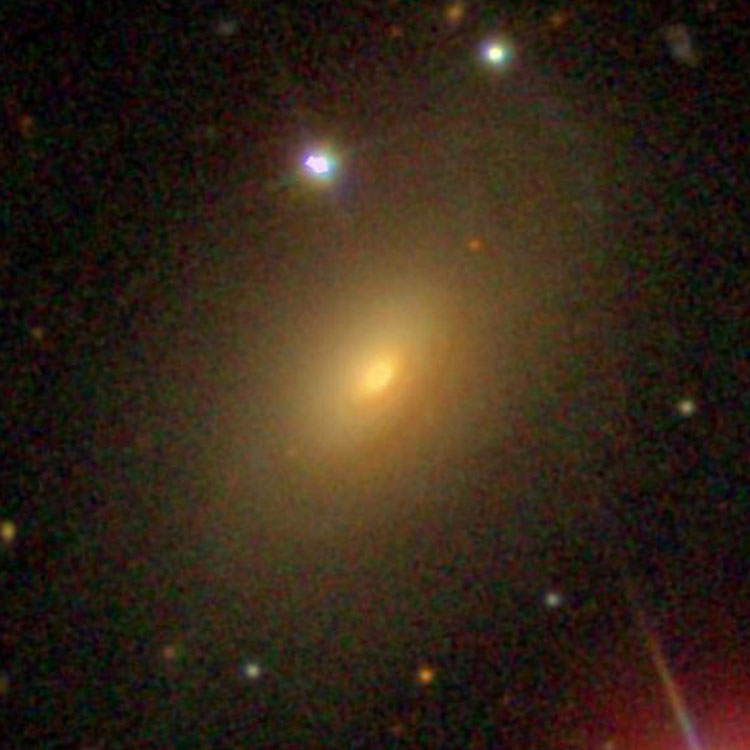
NGC 808 (= PGC 7865)
Discovered (Oct 14, 1830) by John Herschel
A 14th-magnitude spiral galaxy (type SBbc? pec) in Cetus (RA 02 03 56.6, Dec -23 18 42)
Historical Identification: Per Dreyer, NGC 808 (= GC 485 = JH 192 = JH 2458, 1860 RA 01 57 29, NPD 113 58.3) is "very faint, pretty small, very little extended".
Physical Information: Apparent size 1.2 by 0.6 arcmin?

Above, a 12 arcmin wide DSS image centered on NGC 808
Below, a 2.4 arcmin wide DSS image of the galaxy

NGC 809 (= PGC 7889)
Discovered (Nov 1, 1886) by Lewis Swift
Also observed (date?) by Herbert Howe
A 14th-magnitude lenticular galaxy (type (R)S0(r)a?) in Cetus (RA 02 04 19.0, Dec -08 44 07)
Historical Identification: Per Dreyer, NGC 809 (Swift list V (#20), 1860 RA 01 57 46, NPD 99 24.0) is "very faint, small, round". The second Index Catalog lists a corrected RA (per Howe) of 01 57 25.
Physical Information: Apparent size 1.1 by 0.85 arcmin (from images below)
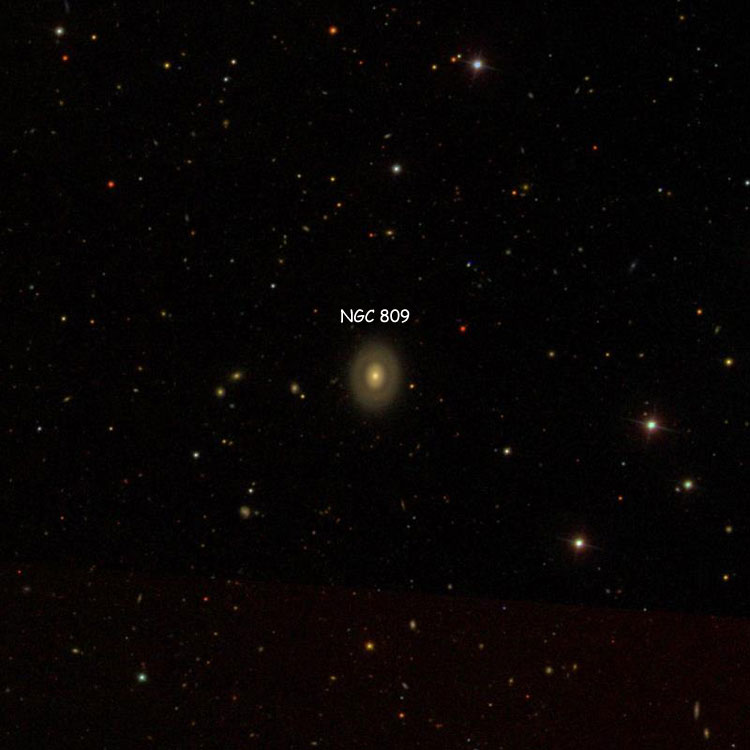
Above, a 12 arcmin wide SDSS image centered on NGC 809
Below, a 1.4 arcmin wide SDSS image of the galaxy
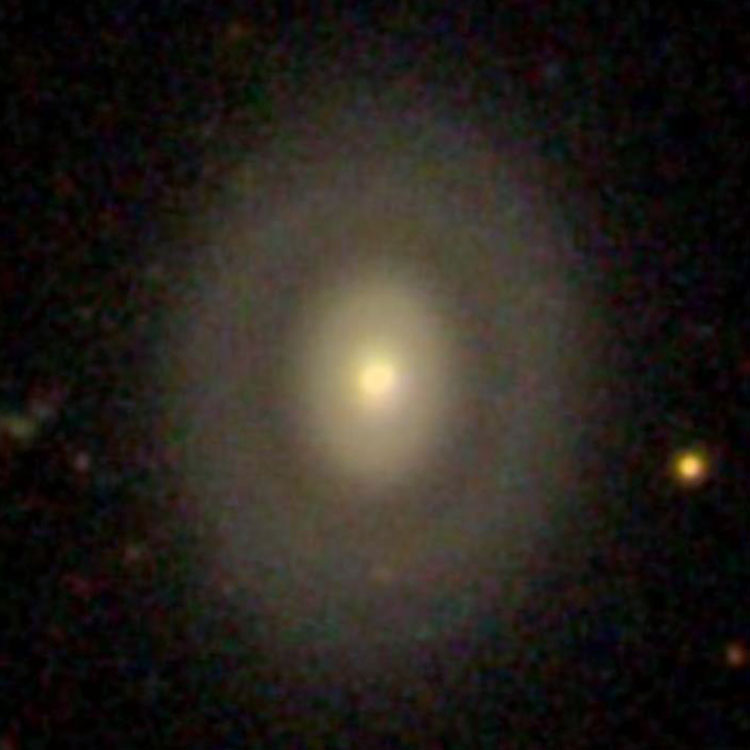
NGC 810 (= PGC 7965)
Discovered (Dec 11, 1871) by Édouard Stephan
A 14th-magnitude elliptical galaxy (type E2? pec) in Aries (RA 02 05 28.6, Dec +13 15 06)
Historical Identification: Per Dreyer, NGC 810 (= GC 5213, Stephan list III (#5), 1860 RA 01 57 47, NPD 77 25.2) is "very faint, very small, round, brighter middle".
Physical Information: Apparent size 1.7 by 1.3 arcmin? NGC 810 appears to have a double nucleus, implying that it may be a double system in the last stages of a merger. It also has a much smaller apparent companion (PGC 3126708, a 16th-magnitude elliptical galaxy (type E5?) of apparent size 0.2 by 0.1 arcmin) at RA 02 05 29.3, Dec +13 15 04, about 0.8s east of the larger galaxy's double nucleus. The recessional velocity of NGC 810 is 7795 km/sec, and PGC 3126708's recessional velocity is 7420 km/sec, so this may be a triple system; but it is at least as likely that PGC 3126708 is a foreground galaxy that just happens to be in the same direction.

Above, a 12 arcmin wide SDSS image centered on NGC 810
Below, a 2.4 arcmin wide SDSS image of the galaxy and its possible companion
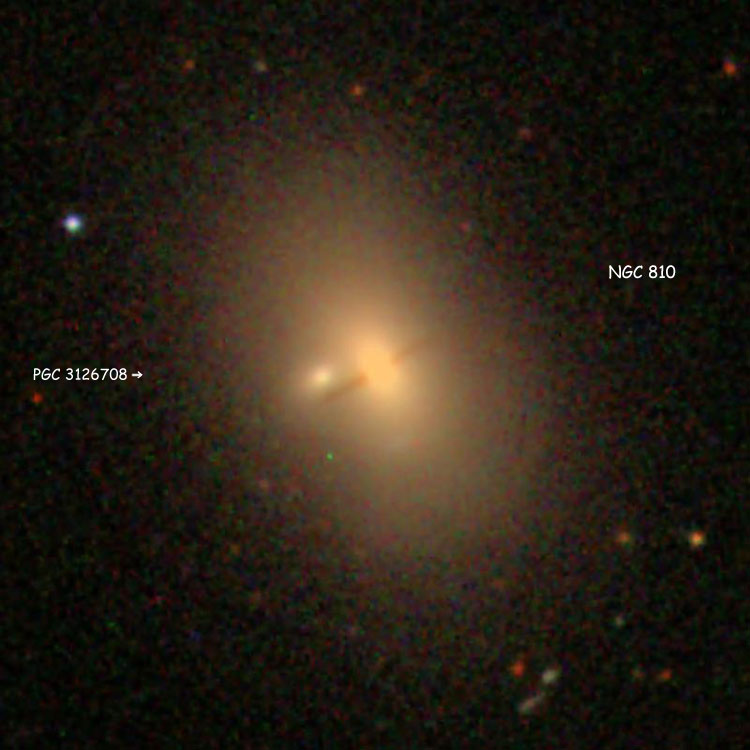
NGC 811 (= PGC 7870)
Discovered (1886) by Francis Leavenworth
Probably a 14th-magnitude lenticular galaxy (type S0?) in Cetus (RA 02 04 00.0, Dec -09 06 22)
Historical Identification: Per Dreyer, NGC 811 (= Leavenworth list II (#324), 1860 RA 01 57 55, NPD 99 46.7) is "extremely faint, extremely small, round (nebulous?), 10th magnitude star 1 arcmin to south". The position precesses to RA 02 04 49.5, Dec -09 06 20, but there is nothing there. This has led to considerable confusion about the identity of the object. Most references associate NGC 811 with PGC 7905, which is therefore discussed immediately below, but per Corwin the correct identification is almost certainly PGC 7870, which lies almost exactly 50s to the west (suggesting a carrying error in the reduction), and exactly matches the description, including the star 1 arcmin to the south.
Physical Information: Based on a recessional velocity of 14665 km/sec, a straightforward calculation indicates that NGC 811 is about 685 million light years away. However, for objects at such distances we should take into account the Universal expansion during the time it took their light to reach us. Doing that shows that the galaxy was about 635 million light years away at the time the light by which we see it was emitted, about 650 million years ago (the difference between the two numbers being due to the expansion of the intervening space during the light-travel time). Given that and its apparent size of 0.45 by 0.45 arcmin, NGC 811 is about 80 to 85 thousand light years across. (Note: Listed in NED as 6dFJ0204000-090622.)

Above, a 12 arcmin wide SDSS image centered on NGC 811
Below, a 0.8 arcmin wide SDSS image of the galaxy
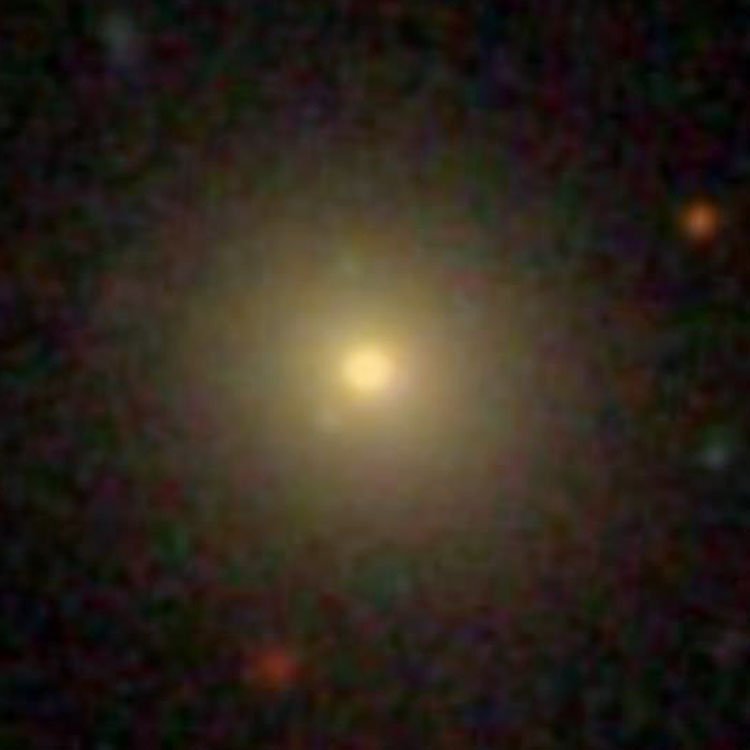
Below, a 20 arcmin wide region centered between Dreyer's position and the actual position of NGC 811
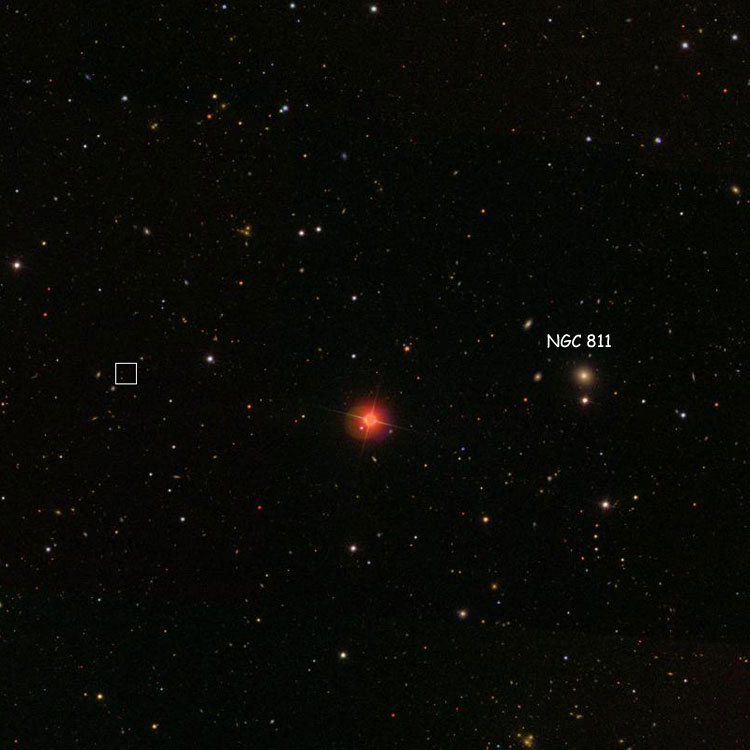
PGC 7905 (not = NGC 811)
Not an NGC object, but listed here because usually misidentified as NGC 811
A 15th-magnitude spiral galaxy (type SB(s)d? pec) in Cetus (RA 02 04 34.8, Dec -10 06 31)
Historical Misdentification: As noted at the entry for NGC 811, PGC 7905 is usually identified as that object. However, that identification is suspect on two counts. First, although errors in declination do occur in the original NGC, they are far less common than errors in right ascension; so the 50s of time error for PGC 7870 is not as surprising as the 70 arcmin error in declination that would be required for PGC 7905 to be Leavenworth's object. Second, the original observation stated that there was a star just south of the galaxy, as is true for PGC 7870 but not for PGC 7905. Still, since PGC 7905 is so commonly misidentified as NGC 811, it seems appropriate to discuss it here.
Physical Information: Based on a recessional velocity of 1925 km/sec, PGC 7905 is about 90 million light years away. Given that and its apparent size of 1.0 by 0.45 arcmin, it is about 25 thousand light years across.
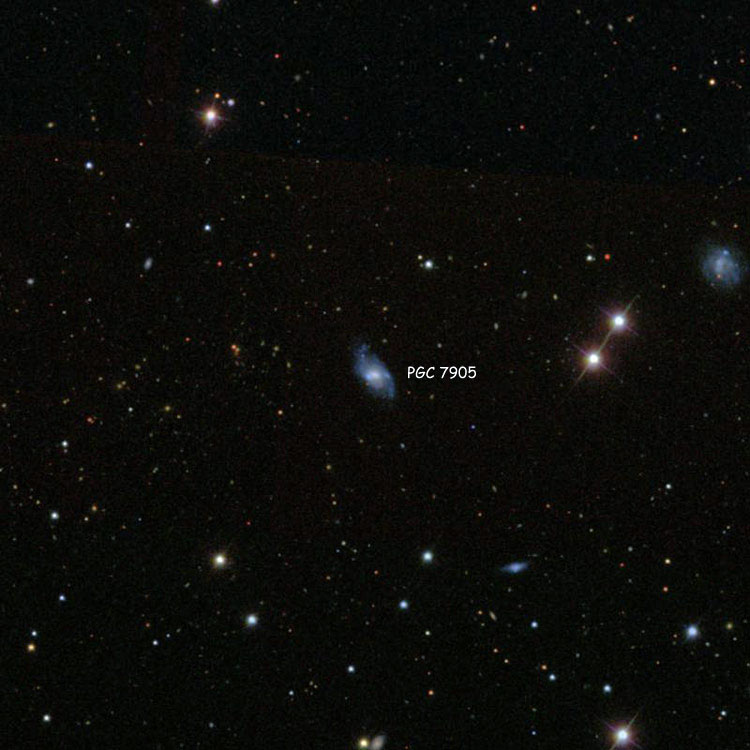
Above, a 12 arcmin wide SDSS image centered on PGC 7905, which is often misidentified as NGC 811
Below, a 1.4 arcmin wide SDSS image of the galaxy
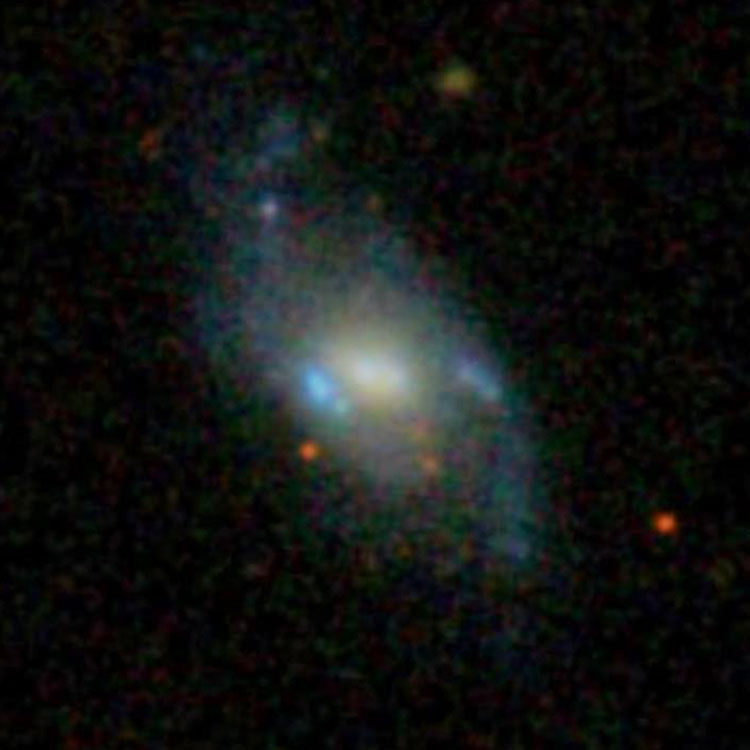
NGC 812 (= PGC 8066)
Discovered (Dec 11, 1876) by Édouard Stephan
An 11th-magnitude spiral galaxy (type Sbc?) in Andromeda (RA 02 06 51.2, Dec +44 34 32)
Historical Identification: Per Dreyer, NGC 812 (= GC 5214, Stephan list VIII (#3), 1860 RA 01 58 09, NPD 46 05.8) is "extremely faint, pretty large, extended 45°, brighter middle".
Physical Information: Apparent size 2.2 by 0.8 arcmin?
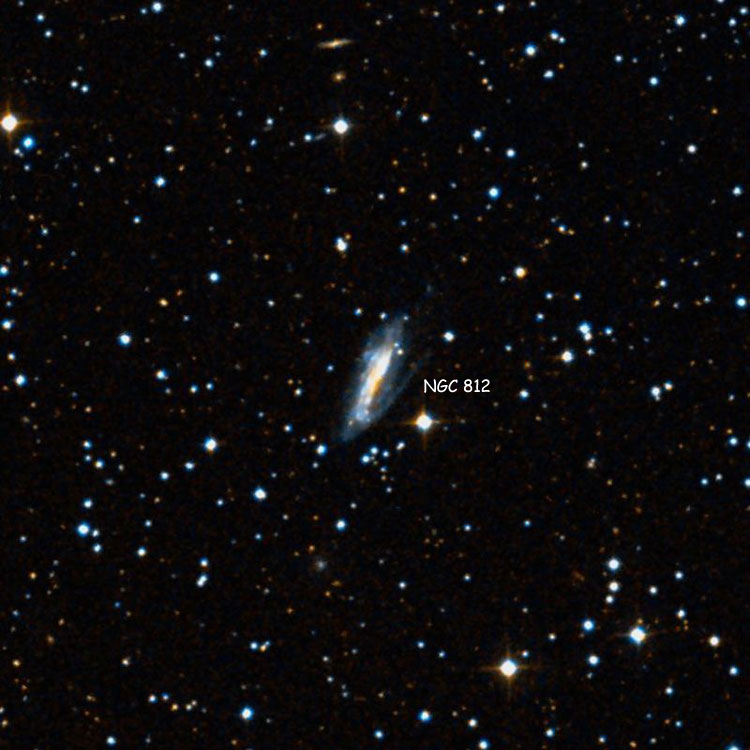
Above, a 12 arcmin wide DSS image centered on NGC 812
Below, a 2.4 arcmin wide DSS image of the galaxy
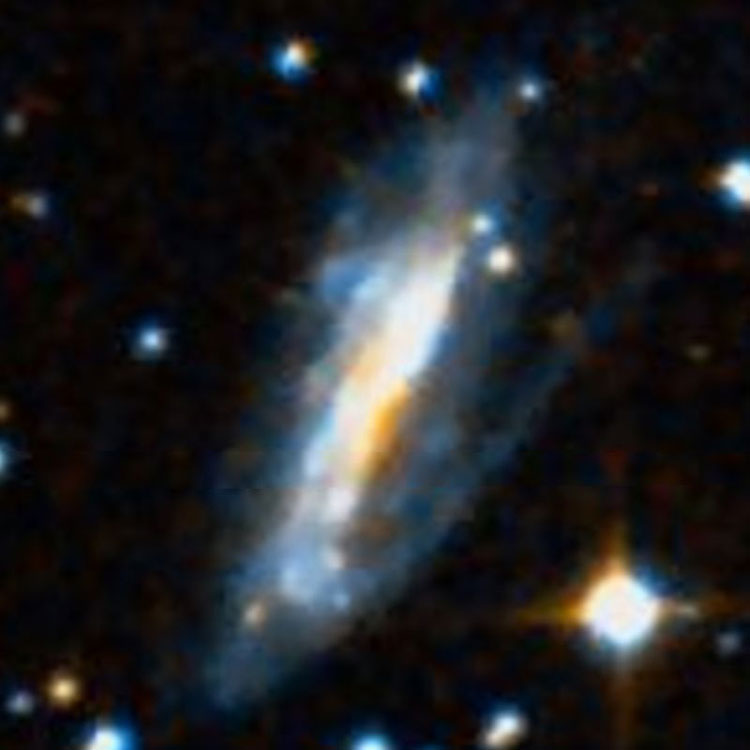
NGC 813 (= PGC 7692)
Discovered (Nov 24, 1834) by John Herschel
A 13th-magnitude lenticular galaxy (type SB0/a) in Hydrus (RA 02 01 36.1, Dec -68 26 21)
Historical Identification: Per Dreyer, NGC 813 (= GC 486 = JH 2459, 1860 RA 01 58 26, NPD 159 07.3) is "pretty faint, small, round, gradually brighter middle".
Physical Information: Apparent size 1.4 by 0.9 arcmin (from images below)

Above, a 12 arcmin wide DSS image centered on NGC 813
Below, a 1.8 arcmin wide DSS image of the galaxy
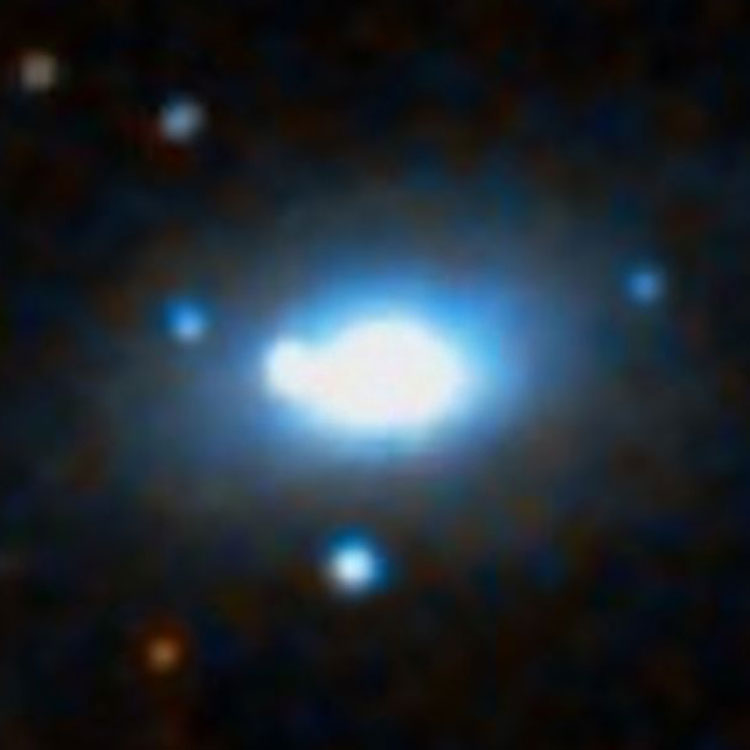
NGC 814 (= PGC 8319)
Discovered (Jan 6, 1886) by Ormond Stone
A 14th-magnitude lenticular galaxy (type SB0/a? pec?) in Cetus (RA 02 10 37.6, Dec -15 46 25)
Historical Identification: Per Dreyer, NGC 814 (Ormond Stone list I (#47), 1860 RA 01 59 35, NPD 106 25.7) is "extremely faint, small, round, gradually brighter middle". The position precesses to RA 02 06 17.7, Dec -15 45 29, but there is nothing there. As a result NGC 814 and 815, which was found by Stone on the same night and suffered the same error in its recorded position, were considered lost or more recently misidentified with a pair of galaxies ( PGC 7799 and 7798, respectively) that have the same difference in their relative position (4 arcmin north and south of each other) as NGC 814 and 815, but lie about 4m west and 70 arcmin north of Stone's positions. Such errors in right ascension, although unfortunate, are not unusual in the NGC, particularly for some observers (such as Stone); and in fact the correct identification of the objects (PGC 8319 and 906183, as shown in the entries here) involves a 4m 20s error in right ascension in the opposite direction (that is, to the east of Stone's position). However, large errors in North Polar Declination are not as common, so the fact that the current candidates for NGC 814 and 815 lie only 1 arcmin south of Stone's position instead of the 70 arcmin north for the prior candidates makes them a far more reasonable identification even without any additional information. However, we needn't try to decide which galaxies are more likely to be what Stone observed merely on the basis of preference, as (per Corwin) Stone made a sketch of the area with an "unmistakable" starfield, making the current identification certain (for novices, this means that the positions of the stars and nebulae in the sky match the sketch only if the nebulae are PGC 8319 and 906183). As a result most major catalogues (such as NED and LEDA) have switched to the new identification, but because of the historical confusion associated with the identification of NGC 814 and 815, other sources (such as Wikisky) still show the older identification, and odds are that at least some confusion will persist for a long time to come; so the objects previously misidentified as these NGC entries are also covered here, immediately following the correct NGC entries.
Physical Information: Based on a recessional velocity of 1615 km/sec, PGC 8319 (= NGC 814) is about 75 million light years away. Given that and its apparent size of 1.4 by 0.6 arcmin, it is about 30 thousand light years across.
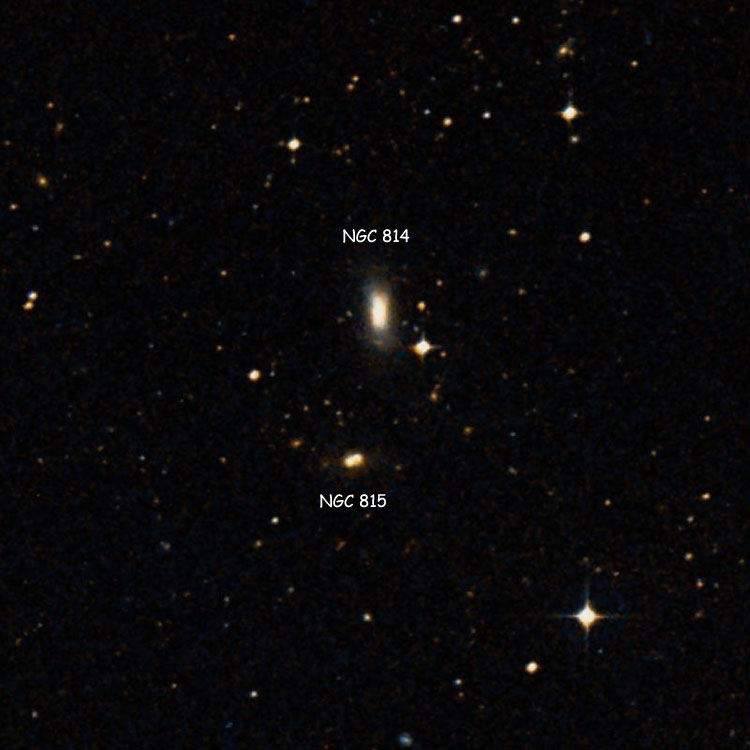
Above, a 12 arcmin wide DSS image centered between the correct NGC 814 and 815
Below, a 2.4 arcmin wide DSS image of the correct NGC 814
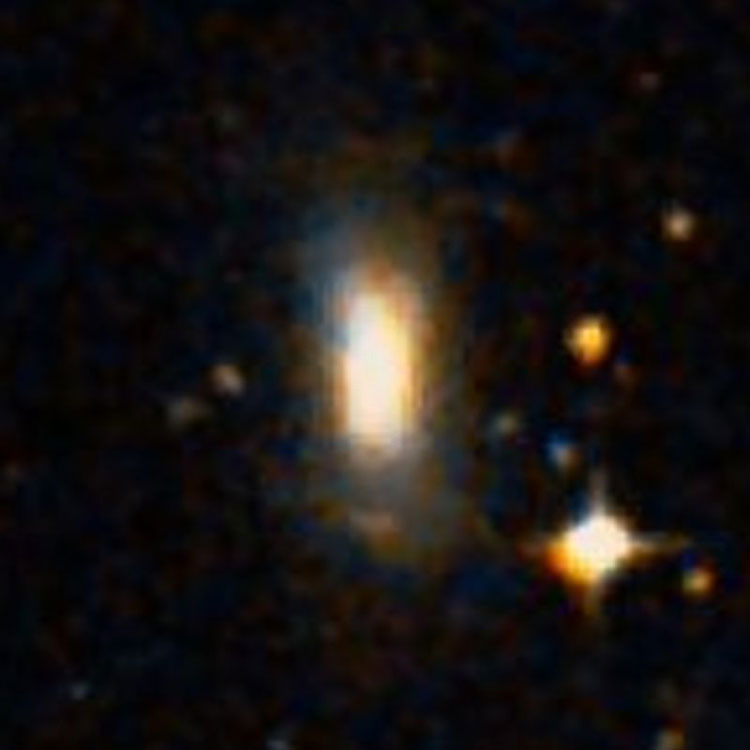
Below, a 12 arcmin wide region centered between Ormond Stone's positions for NGC 814 and 815
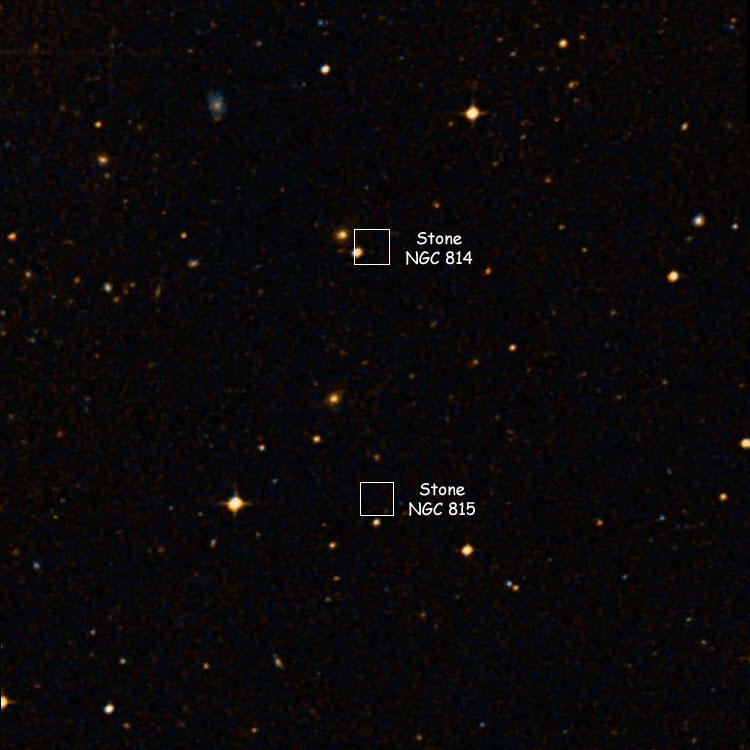 Below, a 2 degree wide region with circles showing Ormond Stone's positions for NGC 814 and 815, the position of the erroneous candidates PGC 7798 and 7799, and the position of the correct NGC objects. The correct positions are at almost the same declination as Stone's, and even without the certainty provided by his sketch of the region, would make the new identification far more likely. 
PGC 7799 (not = NGC 814)
Not an NGC object, but listed here because often misidentified as NGC 814
A 15th-magnitude spiral galaxy (type SB(s)bc?) in Cetus (RA 02 02 56.5, Dec -14 36 32)
Historical Misidentification: As discussed at the entry for NGC 814, PGC 7799 is a recent but erroneous candidate for NGC 814. Since it is about 4m west and nearly 70' north of Stone's position it hardly seems an ideal candidate, but when objects are "lost" misidentifications are common, and since PGC 7799 and 7798 (which was commonly misidentified as NGC 815) are about the same 4 arcmin apart as NGC 814 and 815, the misidentification is understandable, though very unfortunate.
Physical Information: Based on a recessional velocity of 3735 km/sec, PGC 7799 is about 170 to 175 million light years away. Given that and its apparent size of 1.25 by 1.25 arcmin, it is about 60 to 65 thousand light years across.
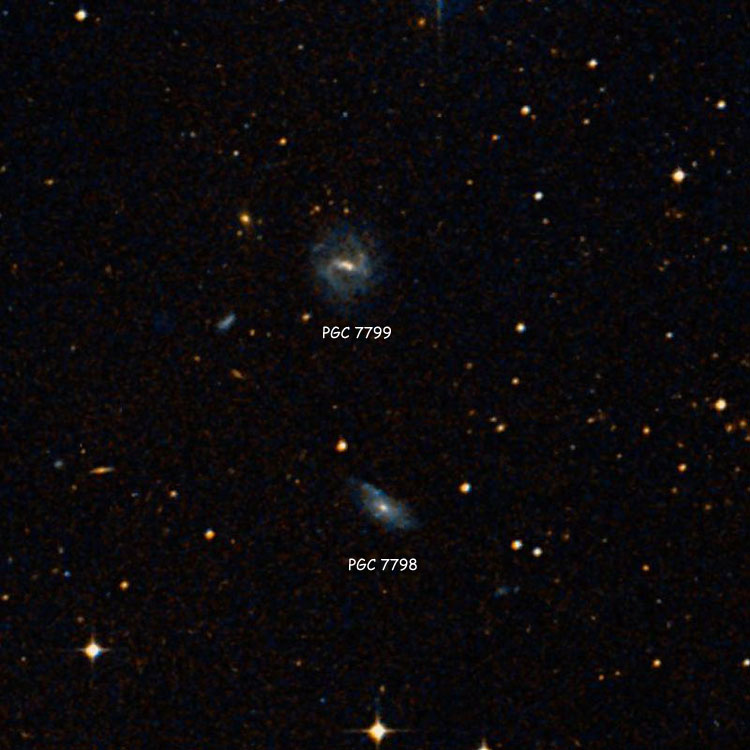
Above, a 12 arcmin wide DSS image centered between PGC 7799 and 7798,
which are often misidentified as NGC 814 and 815
Below, a 1.8 arcmin wide DSS image of PGC 7799
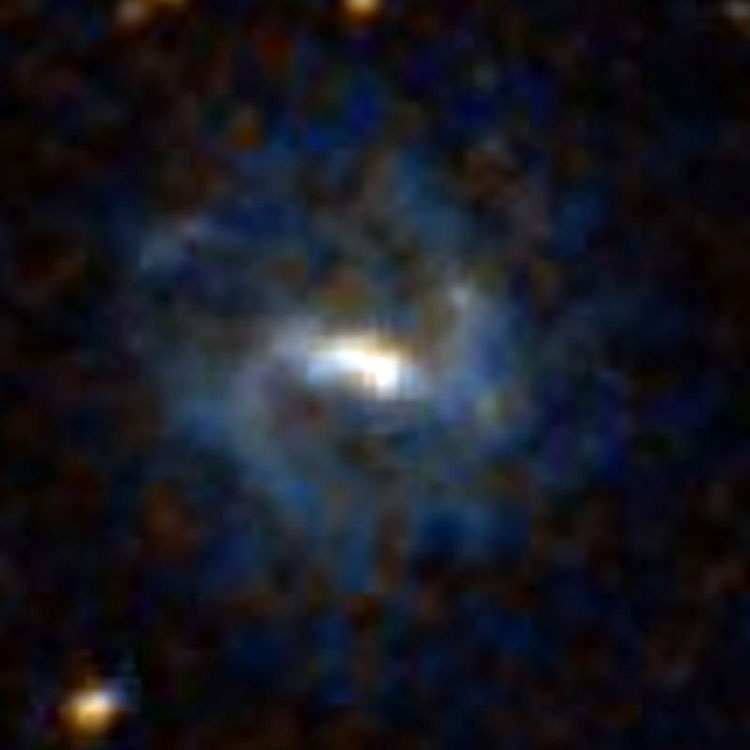
NGC 815 (= PGC 906183)
Discovered (Jan 6, 1886) by Ormond Stone
A 16th-magnitude pair of lenticular galaxies (type S0? + S0?) in Cetus (RA 02 10 39.4, Dec -15 48 46)
Corwin lists the northwestern component at RA 02 10 39.2, Dec -15 48 45
and the southeastern component at RA 02 10 39.5, Dec -15 48 48
Historical Identification: Per Dreyer, NGC 815 (Ormond Stone list I (#48), 1860 RA 01 59 35, NPD 106 29.7) is "extremely faint, very small, round, gradually brighter middle". The position precesses to RA 02 06 17.5, Dec -15 49 29, but there is nothing there, and for a long time the entry was "lost" or misidentified (most recently as PGC 7798). However, as noted in the entry for NGC 814 (which see for a detailed discussion), Stone made a sketch that unmistakably confirms PGC 9318 and PGC 906183 as the correct identification of NGC 814 and 815.
Physical Information: Based on a recessional velocity of 16080 km/sec, a straightforward calculation indicates that NGC 815 is about 750 million light years away. However, for objects at such distances we should take into account the Universal expansion during the time it took their light to reach us. Doing that shows that the galaxy was about 695 million light years away at the time the light by which we see it was emitted, about 715 million years ago (the difference between the two numbers being due to the expansion of the intervening space during the light-travel time). Given that and its apparent size of 0.45 by 0.2 arcmin, the pair spans about 90 thousand light years. (Note: NGC 815 is listed in NED as APMUKS(BJ) B020815.78-160253.1, with the same position that LEDA lists for PGC 906183.)
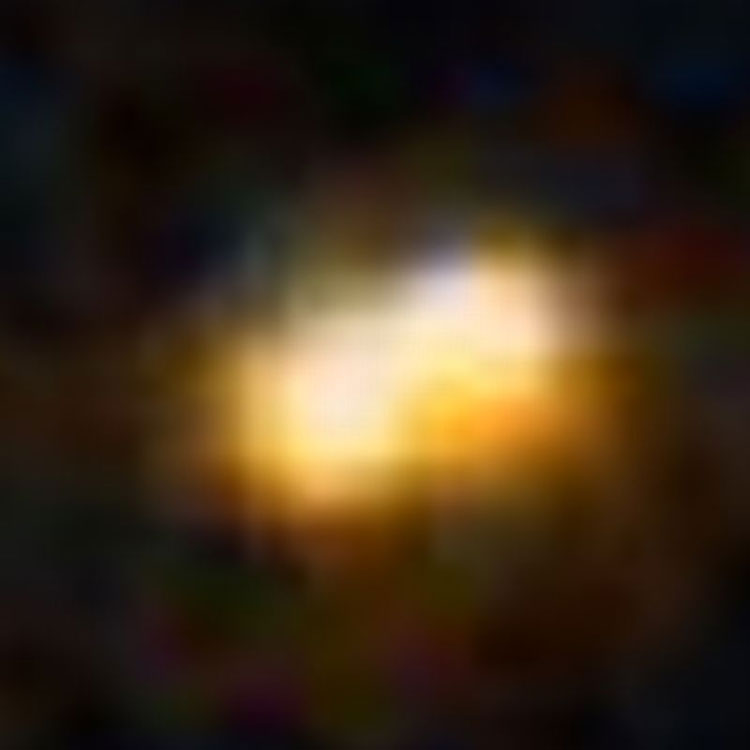
Above, a 0.6 arcmin wide DSS image of the correct NGC 815; see NGC 814 for a wide-field image
PGC 7798 (not = NGC 815)
Not an NGC object, but listed here because often misidentified as NGC 815
A 15th-magnitude spiral galaxy (type SB(s)m?) in Cetus (RA 02 02 54.2, Dec -14 40 23)
Historical Misidentification: As discussed at the entry for NGC 814, PGC 7798 is a recent but erroneous candidate for NGC 815. Since it is about 4m west and nearly 70' north of Stone's position it hardly seems an ideal candidate, but when objects are "lost" misidentifications are common, and since PGC 7798 and 7799 (which was commonly misidentified as NGC 814) are about the same 4 arcmin apart as NGC 815 and 814, the misidentification is understandable, even if unfortunate.
Physical Information: PGC 7798 has an apparent size of 1.3 by 0.4 arcmin (from the image below), but apparently nothing else is available, so its distance and size are unknown.
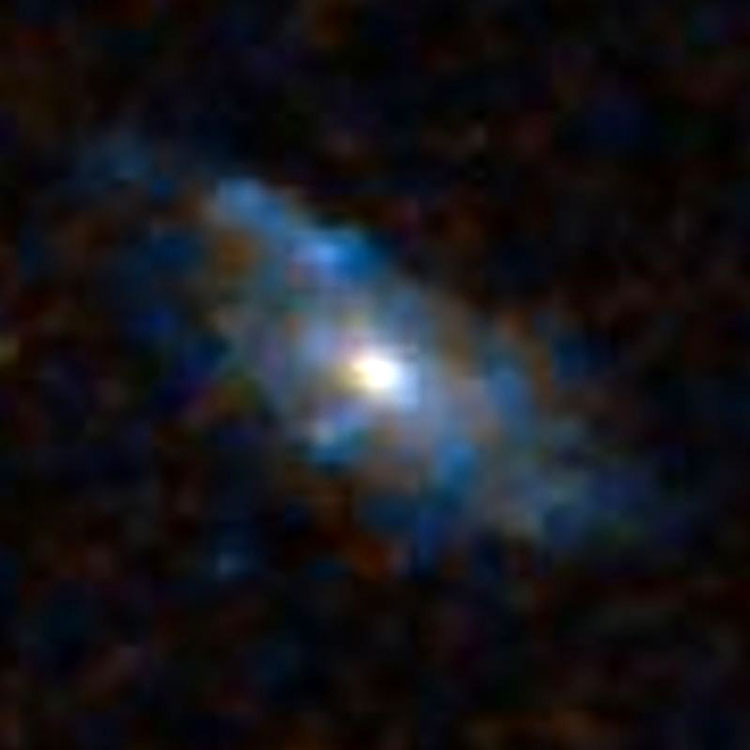
Above, a 1.5 arcmin wide closeup of PGC 7798, which is often misidentified as NGC 815
See PGC 7799 for a wide-field image
NGC 816 (= PGC 8152)
Discovered (Sep 15, 1871) by Édouard Stephan
A 14th-magnitude spiral galaxy (type Sc?) in Triangulum (RA 02 08 08.9, Dec +29 15 21)
Historical Identification: Per Dreyer, NGC 816 (= GC 5215, Stephan list VI (#1), 1860 RA 02 00 05, NPD 61 25.7) is "very faint, very small, irregular figure".
Physical Information: Apparent size 0.4 by 0.4 arcmin (from images below). Perhaps a Seyfert galaxy.
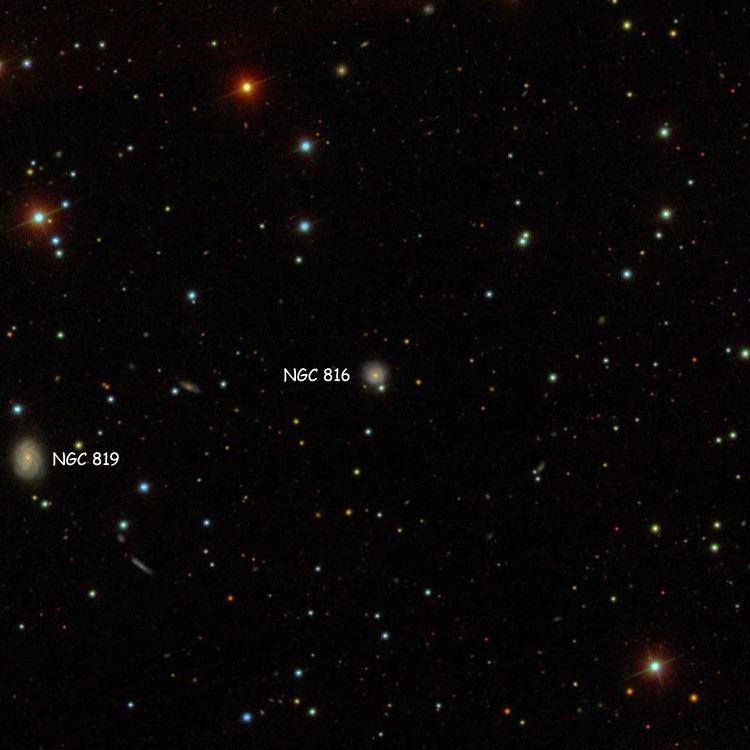
Above, a 12 arcmin wide SDSS image centered on NGC 816, also showing NGC 819
Below, a 0.6 arcmin wide SDSS image of the galaxy

NGC 817 (= PGC 8109)
Discovered (Sep 2, 1886) by Lewis Swift
Also observed (date?) by Guillaume Bigourdan
A 13th-magnitude spiral galaxy (type SAB(s)bc?) in Aries (RA 02 07 33.7, Dec +17 12 09)
Historical Identification: Per Dreyer, NGC 817 (Swift list IV (#7), 1860 RA 02 00 18, NPD 73 27.7) is "extremely faint, very small, round, 2 stars near". The first Index Catalog corrects (per Bigourdan) the seconds of RA to 44.
Physical Information: Apparent size 0.8 by 0.35 arcmin (from images below)
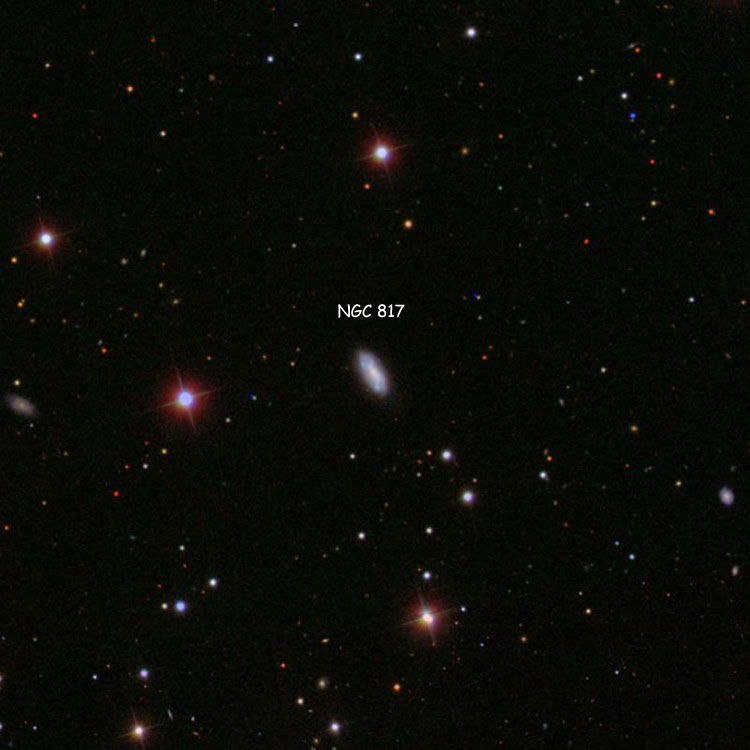
Above, a 12 arcmin wide SDSS image centered on NGC 817
Below, a 1 arcmin wide SDSS image of the galaxy

NGC 818 (= PGC 8185)
Discovered (Oct 18, 1786) by William Herschel
Also observed (date?) by John Herschel
A 13th-magnitude spiral galaxy (type SBbc?) in Andromeda (RA 02 08 44.5, Dec +38 46 38)
Historical Identification: Per Dreyer, NGC 818 (= GC 488 = JH 194 = WH II 604, 1860 RA 02 00 19, NPD 51 54.4) is "pretty bright, considerably large, a little extended, much brighter middle".
Physical Information: Apparent size 2.9 by 1.2 arcmin?

Above, a 12 arcmin wide DSS image centered on NGC 818
Below, a 3 arcmin wide DSS image of the galaxy
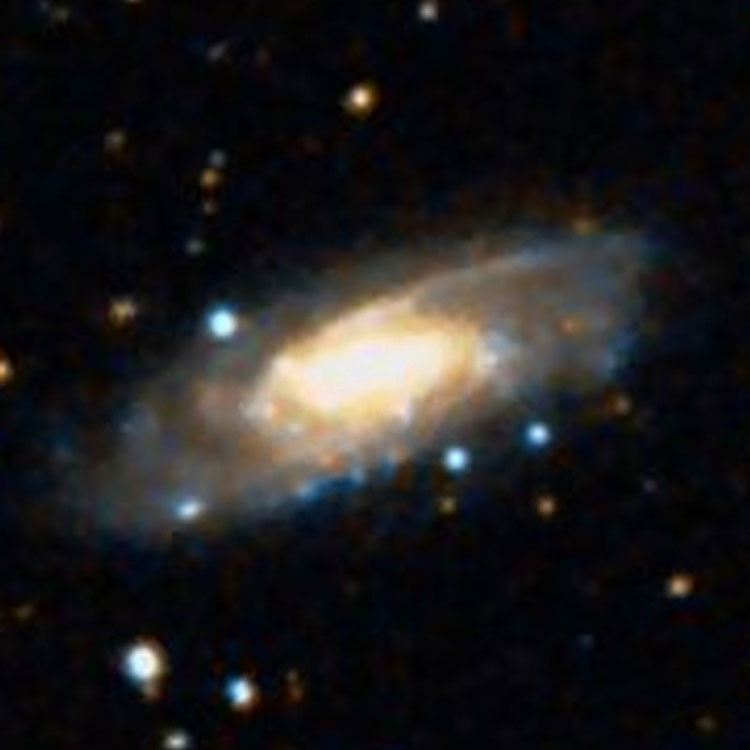
NGC 819 (= PGC 8174)
Discovered (Sep 20, 1865) by Heinrich d'Arrest
Also observed (Sep 15, 1871) by Édouard Stephan
A 14th-magnitude spiral galaxy (type Sbc?) in Triangulum (RA 02 08 34.4, Dec +29 14 02)
Historical Identification: Per Dreyer, NGC 819 (= GC 5216, d'Arrest, Stephan list VI (#??), 1860 RA 02 00 31, NPD 61 27.1) is "pretty faint, very small, round, 13th magnitude star to north".
Physical Information: Apparent size 0.7 by 0.5 arcmin (from images below)
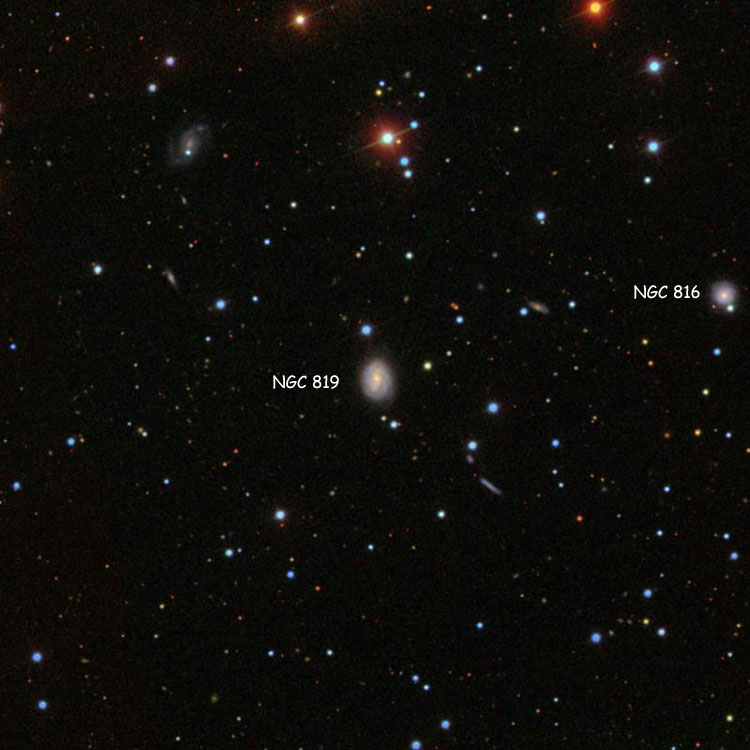
Above, a 12 arcmin wide SDSS image centered on NGC 819, also showing NGC 816
Below, a 1 arcmin wide SDSS image of the galaxy
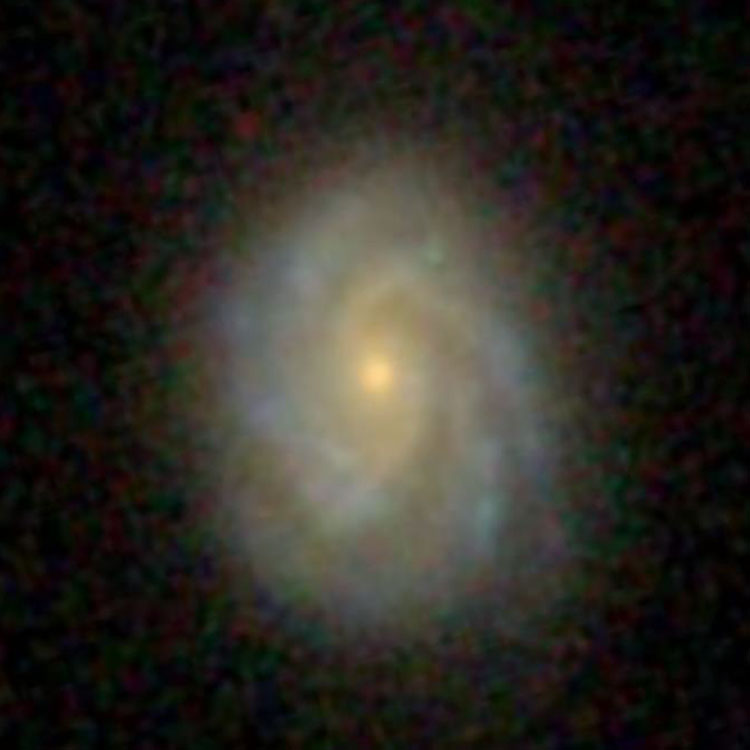
NGC 820 (= PGC 8165)
Discovered (Sep 7, 1828) by John Herschel
A 13th-magnitude spiral galaxy (type Sbc?) in Aries (RA 02 08 25.0, Dec +14 20 58)
Historical Identification: Per Dreyer, NGC 820 (= GC 489 = JH 195, 1860 RA 02 00 50, NPD 76 19.1) is "faint, very small, round, brighter middle".
Physical Information: Apparent size 1.5 by 0.85 arcmin (from the images below)

Above, a 12 arcmin wide SDSS image centered on NGC 820
Below, a 1.6 arcmin wide SDSS image of the galaxy

NGC 821 (= PGC 8160)
Discovered (Sep 4, 1786) by William Herschel
Also observed (date?) by John Herschel
Also observed (Jan 3, 1856) by Heinrich d'Arrest
An 11th-magnitude elliptical galaxy (type E3?) in Aries (RA 02 08 21.1, Dec +10 59 42)
Historical Identification: Per Dreyer, NGC 821 (= GC 487 = JH 193 = WH I 152, d'Arrest, 1860 RA 02 00 53, NPD 79 40.4) is "pretty bright, very small, very little extended, suddenly very much brighter middle, 10th magnitude star 1 arcmin to northwest".
Physical Information: Apparent size 2.4 by 1.7 arcmin?
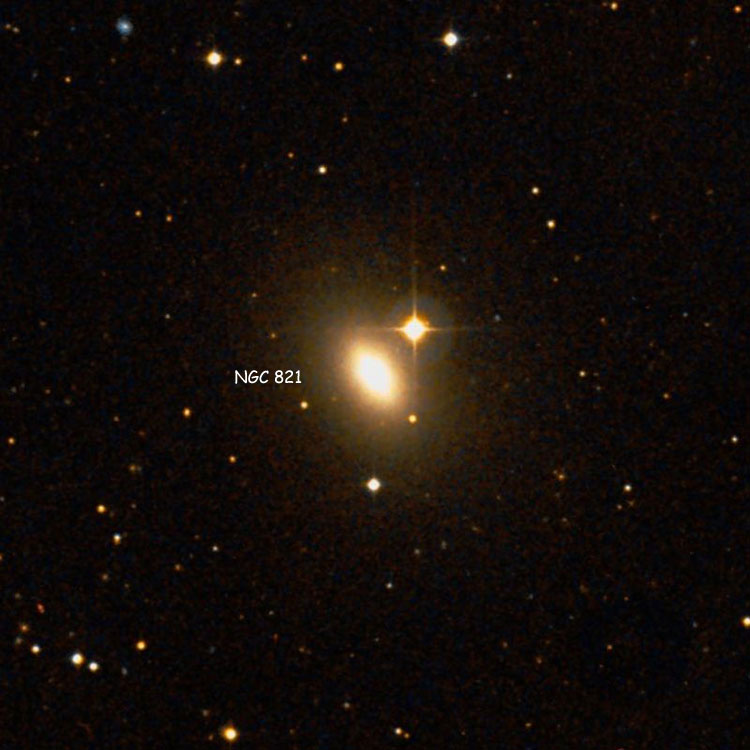
Above, a 12 arcmin wide DSS image centered on NGC 821
Below, a 2.4 arcmin wide DSS image of the galaxy
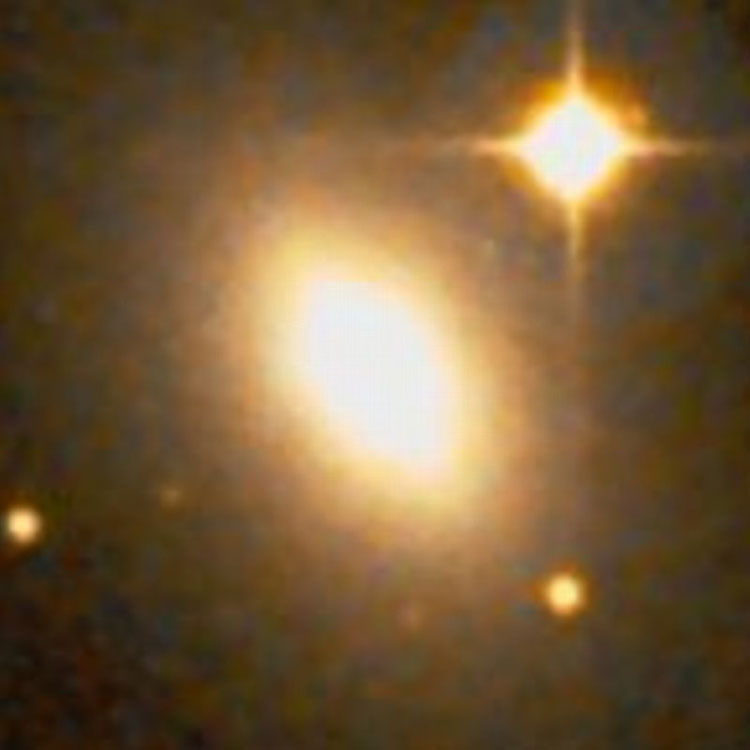
NGC 822 (= PGC 8055)
Discovered (Sep 5, 1834) by John Herschel
A 13th-magnitude lenticular galaxy (type E/S0?) in Phoenix (RA 02 06 39.2, Dec -41 09 24)
Historical Identification: Per Dreyer, NGC 822 (= GC 490 = JH 2461, 1860 RA 02 00 55, NPD 131 49.2) is "considerably faint, very small, round, suddenly brighter middle, mottled but not resolved".
Physical Information: Apparent size 1.5 by 0.95 arcmin (from images below)
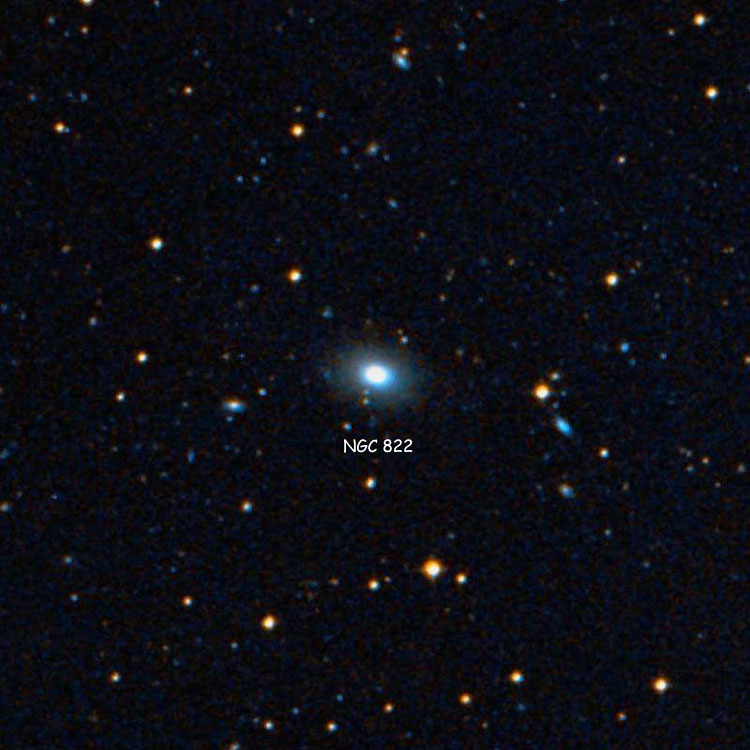
Above, a 12 arcmin wide DSS image centered on NGC 822
Below, a 2 arcmin wide DSS image of the galaxy
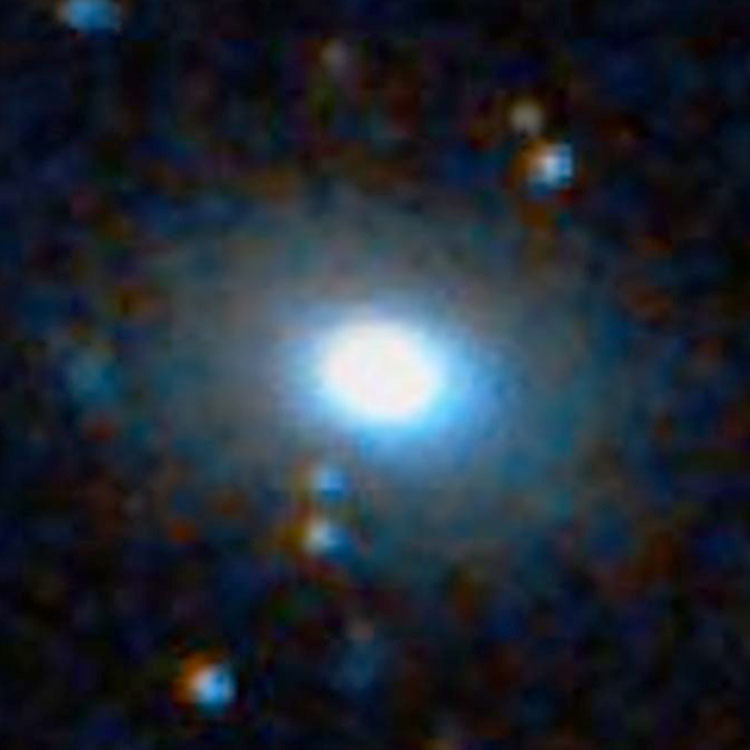
NGC 823 (= IC 1782 = PGC 8093)
Discovered (Oct 14, 1830) by John Herschel (and later listed as NGC 823)
Discovered (Oct 8, 1896) by Lewis Swift (and later listed as IC 1782)
A 13th-magnitude lenticular galaxy (type S0/a?) in Fornax (RA 02 07 20.0, Dec -25 26 31)
Historical Identification: Per Dreyer, NGC 823 (= GC 491 = JH 196 = JH 2460, 1860 RA 02 00 57, NPD 116 07.3) is "very faint, very faint double star involved".
Physical Information: Apparent size 1.7 by 1.2 arcmin (from images below)
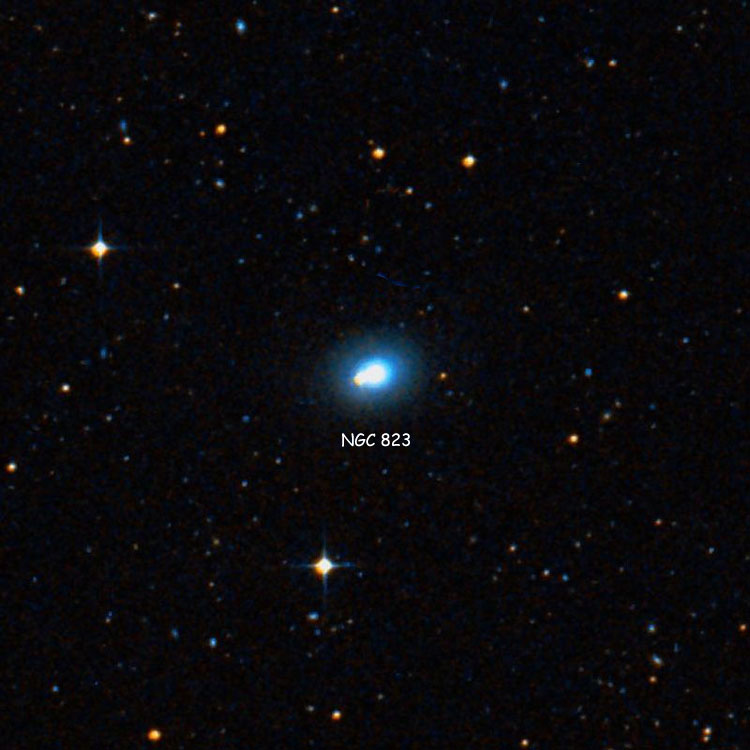
Above, a 12 arcmin wide DSS image centered on NGC 823
Below, a 2.2 arcmin wide DSS image of the galaxy
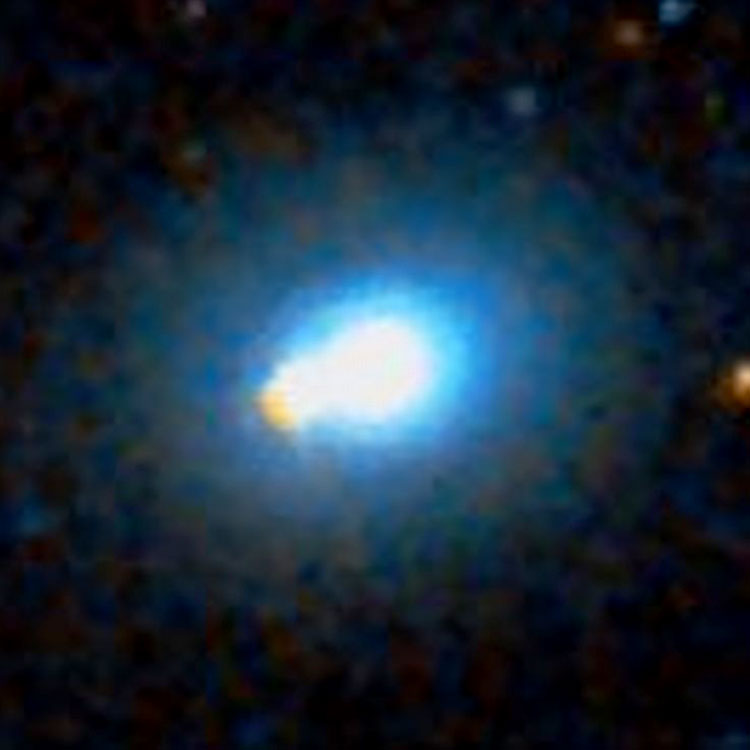
NGC 824 (= PGC 8068)
Discovered (Nov 29, 1837) by John Herschel
A 13th-magnitude spiral galaxy (type SBbc?) in Fornax (RA 02 06 53.2, Dec -36 27 11)
Historical Identification: Per Dreyer, NGC 824 (= GC 492 = JH 2462, 1860 RA 02 00 58, NPD 127 09.2) is "faint, small, round, very suddenly very much brighter middle equivalent to 13th magnitude star".
Physical Information: Apparent size 1.4 by 1.2 arcmin?
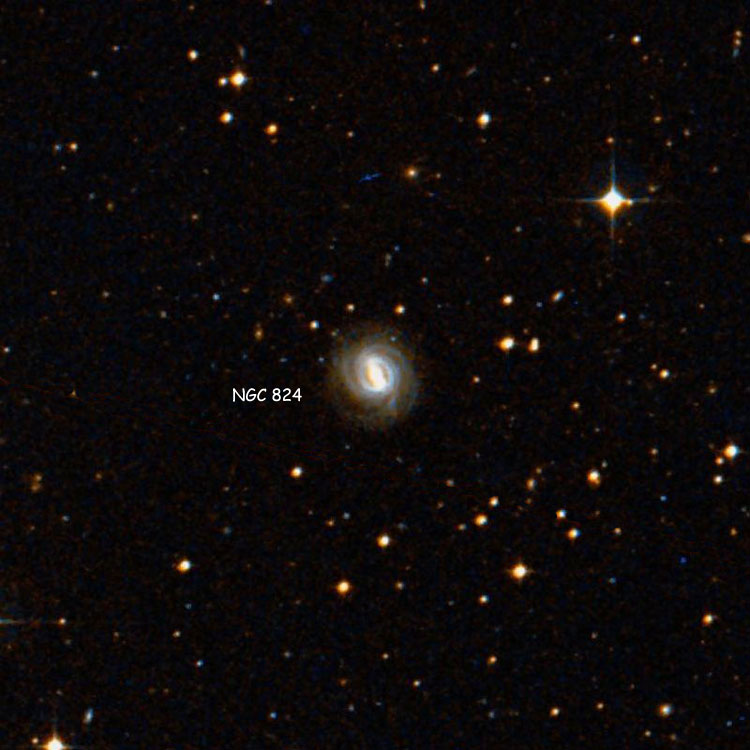
Above, a 12 arcmin wide DSS image centered on NGC 824
Below, a 2.4 arcmin wide DSS image of the galaxy

NGC 825 (= PGC 8173)
Discovered (Nov 18, 1863) by Albert Marth
A 13th-magnitude spiral galaxy (type Sa?) in Cetus (RA 02 08 32.3, Dec +06 19 25)
Historical Identification: Per Dreyer, NGC 825 (= GC 5217, Marth #53, 1860 RA 02 01 11, NPD 84 22) is "faint, small, much extended".
Physical Information: Apparent size 2.0 by 0.5 arcmin?
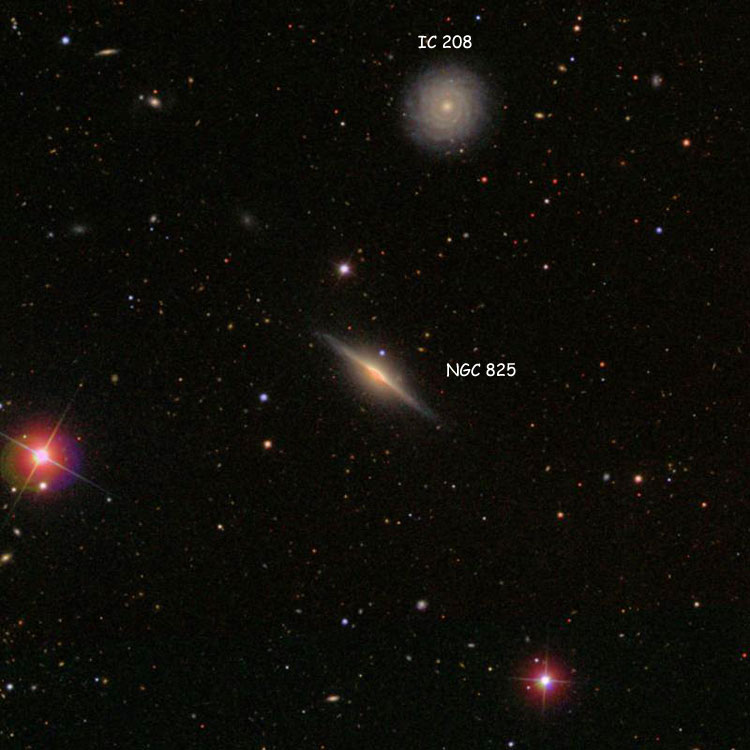
Above, a 12 arcmin wide SDSS image centered on NGC 825, also showing IC 208
Below, a 2.4 arcmin wide SDSS image of the galaxy

NGC 826 (= PGC 8230)
Discovered (Sep 18, 1871) by Édouard Stephan
The brighter member of an apparent pair of galaxies in Triangulum
NGC 826 = A 14th-magnitude spiral galaxy (type Sa? pec) at RA 02 09 25.1, Dec +30 44 23
"NGC 826-2" = A 15th-magnitude spiral galaxy (type SABb? pec) at RA 02 09 24.8, Dec +30 44 36
Historical Identification: Per Dreyer, NGC 826 (= GC 5218 = Stephan list VI (#3), 1860 RA 02 01 18, NPD 59 55.5) is "extremely faint, small, round, a little brighter middle". The position precesses to RA 02 09 25.4, Dec +30 44 27, essentially dead-on PGC 8230, so the identification is certain.
Physical Information: Based on a recessional velocity of 4865 km/sec, NGC 826 is about 225 million light years away. Given that and its apparent size of 0.75 by 0.45 arcmin, it is about 50 thousand light years across. As far as its companion is concerned, it cannot have made any significant contribution to what Stephan saw, so as far as the NGC listing is concerned its presence is merely an accident, and PGC 8230 is NGC 826; but as the 'name' of the companion shows, it is treated as one component of a multiple galaxy. In some cases that would be mentioned in discussions of the larger galaxy; but every reference to PGC 8230 lists it as a single object, so its companion must be treated as a separate entity. However, other than its apparent size of 0.3 by 0.1 arcmin and the information in the single line above, I can find nothing about "NGC 826-2". There is no mention of it or any other object near its position (save for NGC 826 itself) in any catalog, and its appellation as NGC 826-2 appears to have been created only for the purpose of discussing it in entries such as this one. It isn't even clear whether it is actually a physical companion of the larger galaxy, or merely an optical double. There is some dusty obscuration from NGC 826 passing in front of the eastern arm of the smaller galaxy, indicating that it lies beyond its apparent companion, but how far beyond is unknown, so whether the two are physically associated or not is also unknown.

Above, a 12 arcmin wide SDSS image centered on NGC 826
Below, a 2.4 arcmin wide SDSS image of the galaxy and its apparent companion

NGC 827 (= PGC 8196)
Discovered (Nov 7, 1784) by William Herschel
Also observed (date?) by John Herschel
Also observed (Oct 9, 1884) by Lewis Swift
A 13th-magnitude spiral galaxy (type Sbc?) in Cetus (RA 02 08 56.3, Dec +07 58 18)
Historical Identification: Per Dreyer, NGC 827 (= GC 493 = JH 198 = WH III 227, 1860 RA 02 01 34, NPD 82 41.7) is "very faint, small, extended, brighter middle, among stars".
Discovery Notes: The observation by Swift is noted by Steinicke, but it is not obvious why, as it does not appear to have been used by Dreyer, and under normal circumstances only observations that affected the NGC/IC would be listed; but I will research the matter and discuss it in a later iteration of this page.
Physical Information: Apparent size 2.0 by 0.6 arcmin?
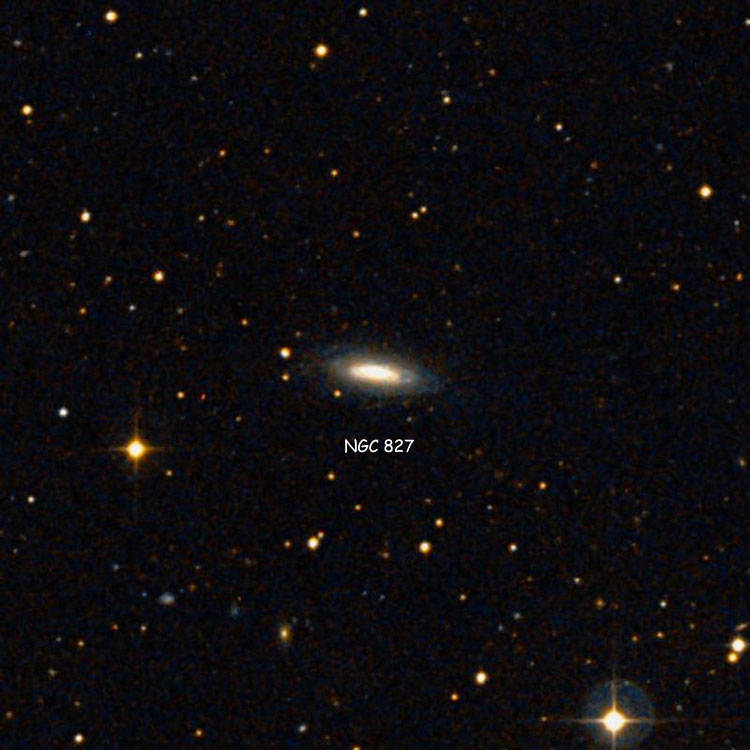
Above, a 12 arcmin wide DSS image centered on NGC 827
Below, a 2.4 arcmin wide DSS image of the galaxy

NGC 828 (= PC 8283)
Discovered (Oct 18, 1786) by William Herschel
Also observed (date?) by John Herschel
A 12th-magnitude spiral galaxy (type Sa? pec) in Andromeda (RA 02 10 09.5, Dec +39 11 25)
Historical Identification: Per Dreyer, NGC 828 (= GC 494 = JH 197 = WH II 605, 1860 RA 02 01 40, NPD 51 28.4) is "pretty bright, small, irregularly round, double star 15 arcmin to east".
Physical Information: Apparent size 2.5 by 1.6 arcmin?
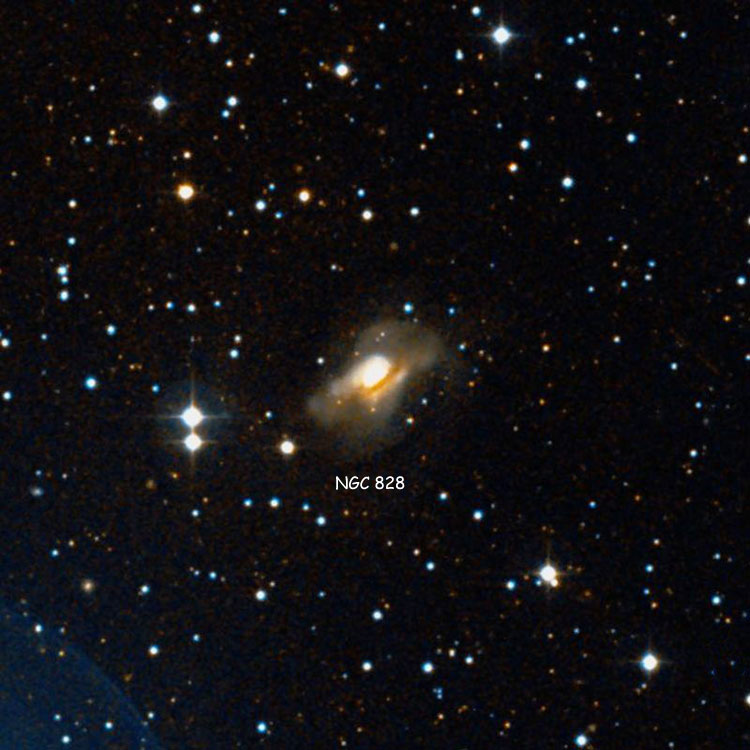
Above, a 12 arcmin wide DSS image centered on NGC 828
Below, a 3 arcmin wide DSS image of the galaxy
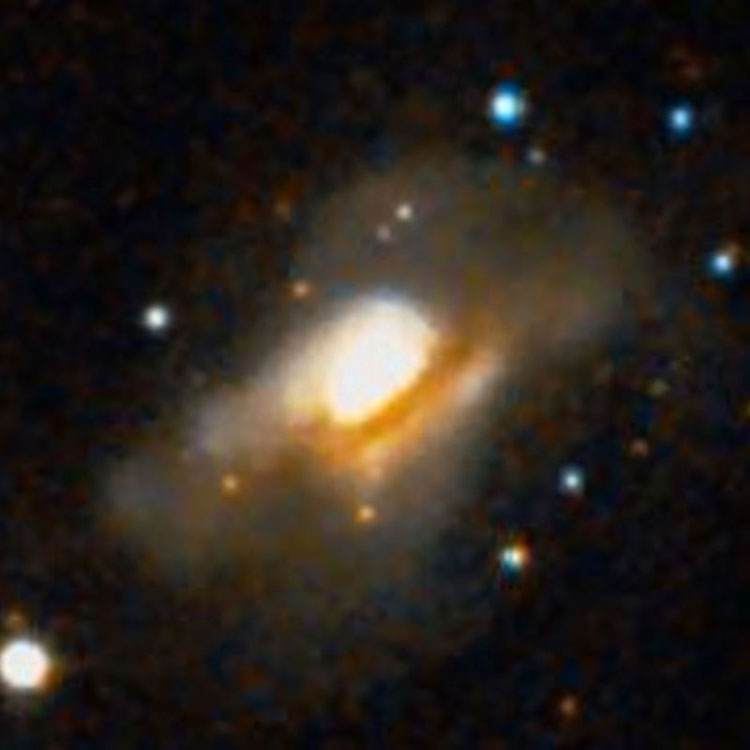
NGC 829 (= PGC 8182)
Discovered (Sep 23, 1865) by Heinrich d'Arrest
A 14th-magnitude spiral galaxy (type Sc?) in Cetus (RA 02 08 42.2, Dec -07 47 26)
Historical Identification: Per Dreyer, NGC 829 (= GC 5219, d'Arrest, 1860 RA 02 01 45, NPD 98 25.8) is "faint, small, 11th magnitude star to south, 1st of 3", the others being NGC 830 and 842.
Physical Information: Apparent size 1.1 by 0.7 arcmin (from images below)
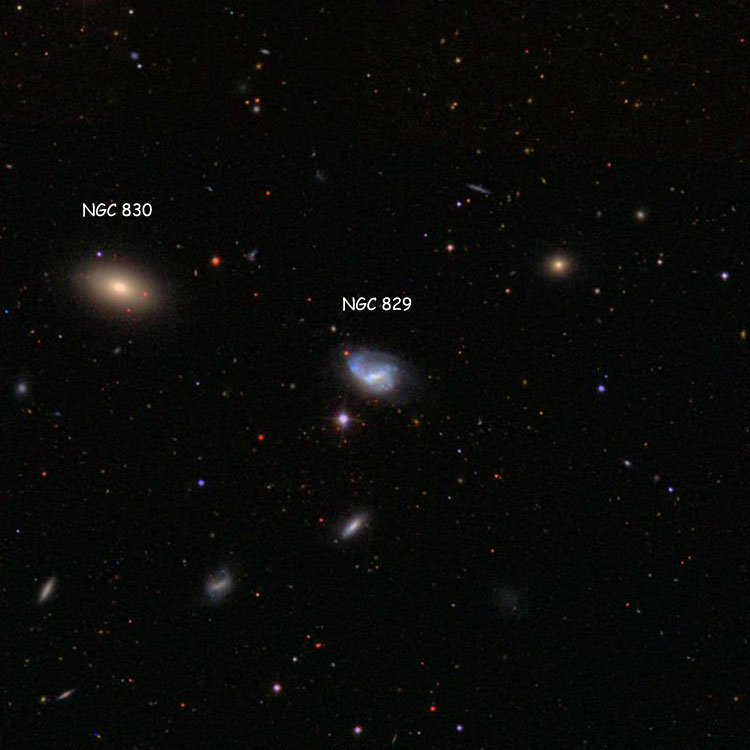
Above, a 12 arcmin wide SDSS image centered on NGC 829, also showing NGC 830
Below, a 1.5 arcmin wide SDSS image of the galaxy

NGC 830 (= PGC 8201)
Discovered (Sep 23, 1865) by Heinrich d'Arrest
A 13th-magnitude lenticular galaxy (type E/S0?) in Cetus (RA 02 08 58.7, Dec -07 46 01)
Historical Identification: Per Dreyer, NGC 830 (= GC 5220, d'Arrest, 1860 RA 02 02 02, NPD 98 25.5) is "pretty faint, very small, round, 2nd of 3", the others being NGC 829 and 842.
Physical Information: Apparent size 1.35 by 0.75 arcmin (from images below)
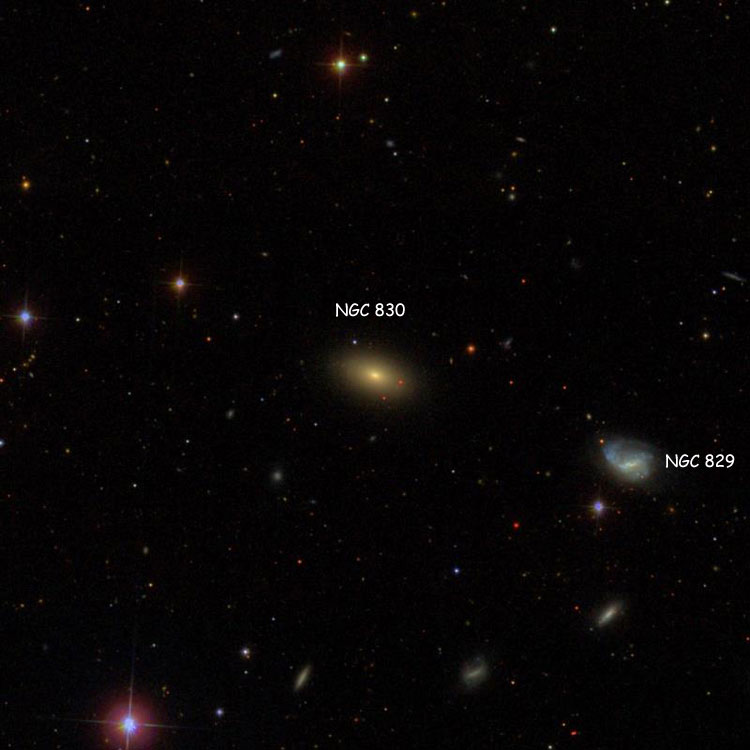
Above, a 12 arcmin wide SDSS image centered on NGC 830, also showing NGC 829
Below, a 1.8 arcmin wide SDSS image of the galaxy
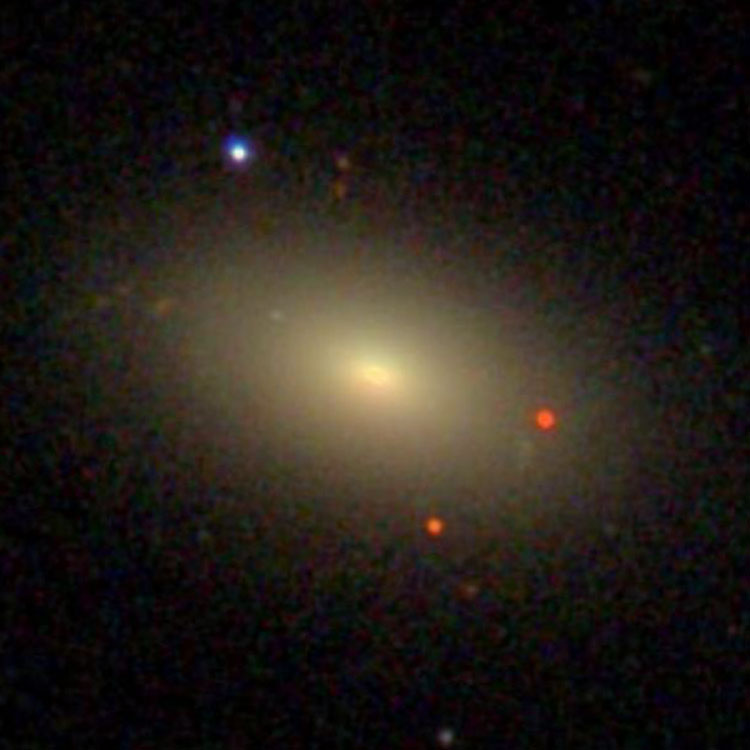
NGC 831 (= PGC 8241)
Discovered (Nov 18, 1863) by Albert Marth
A 15th-magnitude spiral galaxy (type SB(rs)bc? pec) in Cetus (RA 02 09 34.6, Dec +06 05 47)
Historical Identification: Per Dreyer, NGC 831 (= GC 5221, Marth #54, 1860 RA 02 02 16, NPD 84 34) is "very faint, pretty small".
Physical Information: Apparent size 0.6 by 0.6 arcmin (from the images below)

Above, a 12 arcmin wide SDSS image centered on NGC 831
Below, a 0.9 arcmin wide SDSS image of the galaxy

NGC 832 (= NGC 1226 = PGC 11879)
Misrecorded (Sep 17, 1865) by Heinrich d'Arrest (and later listed as NGC 832)
Discovered (Dec 6, 1879) by Édouard Stephan (and later listed as NGC 1226)
A 13th-magnitude elliptical galaxy (type E3?) in Perseus (RA 03 11 05.4, Dec +35 23 12)
Historical Identification: Per Dreyer, NGC 832 (= GC 5222, d'Arrest, 1860 RA 02 02 17, NPD 55 07.6) is "faint, very small, 9th or 10th magnitude star to southwest". The position precesses to RA 02 10 36.5, Dec +35 32 14, but there is nothing there. For a time, a pair of faint stars 24 seconds of time to the east of d'Arrest's position was thought to be what d'Arrest saw, as there is a 10th magnitude star to their southwest; and for that reason, the pair is discussed immediately below. However, in mid 2016 Corwin noticed that there is a galaxy an hour of time to the east of d'Arrest's position that exactly matches his description, down to a 10th magnitude star to its southwest. Since d'Arrest is known to have made similar single-digit misrecordings of his observations in several cases, the identification of that galaxy as NGC 832 is essentially certain (changing d'Arrest's RA to 03 11 00.9 leads to a modern position of RA 03 11 03.1, Dec +35 24 30, less than 1.4 arcmin north northwest of the galaxy listed above, and the star to its southwest seems to make the identification certain). As it happens, that galaxy was already listed in the NGC as NGC 1226, so d'Arrest's misrecorded observation simply led to a duplicate entry; and due to the so recent realization of what went wrong, it is essentially certain that the galaxy will continue to be called NGC 1226, and NGC 832 will be relegated to the status of a duplicate entry.
A Possible Caveat: Although it is almost certain that NGC 832 is a duplicate observation of NGC 1226, there is an uncertainty in the identification, partially based as it is on the "9th or 10th magnitude star to southwest". d'Arrest's paper mentions only one star to the southwest ("praec. ad meridiem") about 5 arcmin from the nebula, but there are two 10th magnitude stars nearby: a slightly brighter one about 6 arcmin southwest, and a slightly fainter one about 4 arcmin west southwest. If neither star were mentioned, the nearly perfect position of a presumed 1 hour error in the RA would be enough to make the identification reasonably certain, and if d'Arrest's description mentioned two stars, it would be considered absolutely certain. But since d'Arrest only mentions one, Corwin's suggestion includes a question about whether the second star makes the identification less certain. The consensus of other experts is that this is not a serious problem, and the identification is far more likely to be correct than the previous one, but the final version of this story is yet to be written.
Physical Information: Given the duplicate entry, see NGC 1226 for anything else.
PGC 8280 (not = NGC 832)
Not an NGC object but listed here since formerly misidentified as NGC 832
A pair of stars in Triangulum (RA 02 11 00.9, Dec +35 32 30)
Historical Misidentification: As noted in the entry for NGC 832, there is nothing at d'Arrest's position for that object; but there is a pair of stars 24 seconds of time to the east of his position with a 10th magnitude star to their southwest. On that basis it was suggested that if NGC 832 was not "lost or nonexistent", it might be the pair of stars, and they have been listed as NGC 832 in numerous catalogs for quite some time (and in fact, were listed as such in earlier versions of this site). However, as noted in the current entry for NGC 832, it turns out that a far superior candidate exists, involving a simple 1 hour error in d'Arrest's recording of his observation (something he is known to have done on other occasions), and that object, which is listed as NGC 1226, is now considered to almost certainly be the actual NGC 832. However, given the relatively long standing of the misidentification of the pair of stars as NGC 832, it is appropriate to post their history here as a warning for those who have run across a database that has yet to be corrected. (As examples of how such misidentifications can become entrenched in the literature, as of August 2016 LEDA and NED list the stars as PGC 8280 = NGC 832, something they would certainly not have done if not for their misidentification as NGC 832.)
Physical Information:
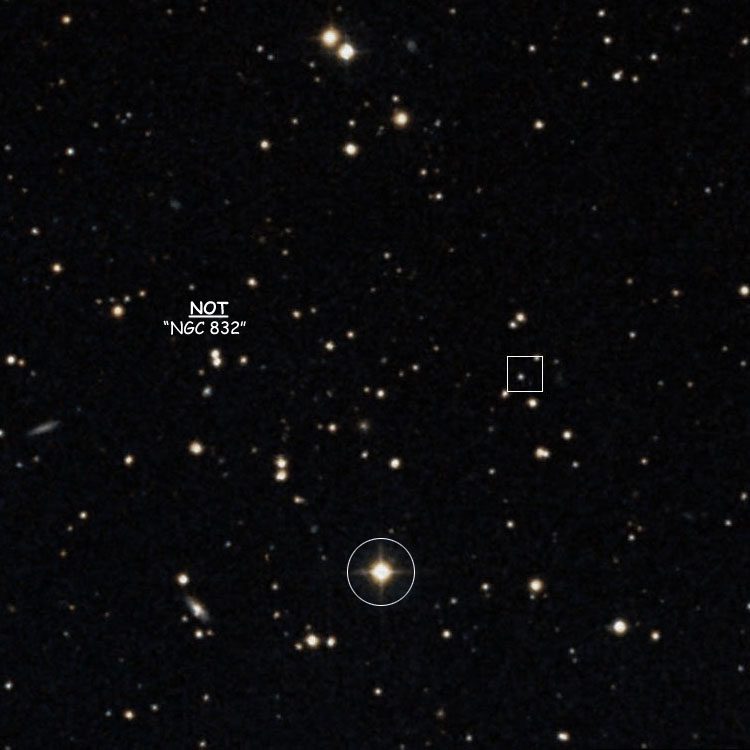
Above, a 12 arcmin wide region showing d'Arrest's position for NGC 832 (shown by a box) and the pair of stars to the east of his position that were misidentified as what he observed. The 10th-magnitude star that made the misidentification seem reasonable is circled, but the new identification of NGC 832 as a misrecorded observation of NGC 1226 relies on a similar but far more convincing argument; so this image merely serves to show how the misidentification of the stars as NGC 832 was made.
NGC 833 (= PGC 8225 = HCG 16B,
and with NGC 835, 838 and 839 = Arp 318 = Hickson Compact Group 16)
Discovered (Nov 28, 1785) by William Herschel
Also observed (date?) by John Herschel
A 13th-magnitude spiral galaxy (type Sa? pec) in Cetus (RA 02 09 20.8, Dec -10 07 59)
Historical Identification: Per Dreyer, NGC 833 (= JH 199 = JH 2463 = WH II 482, 1860 RA 02 02 30, NPD 100 47.6) is "faint, small, round, 1st of 4", the others being NGC 835, 838 and 839.
Physical Information: Apparent size 1.5 by 0.7 arcmin?
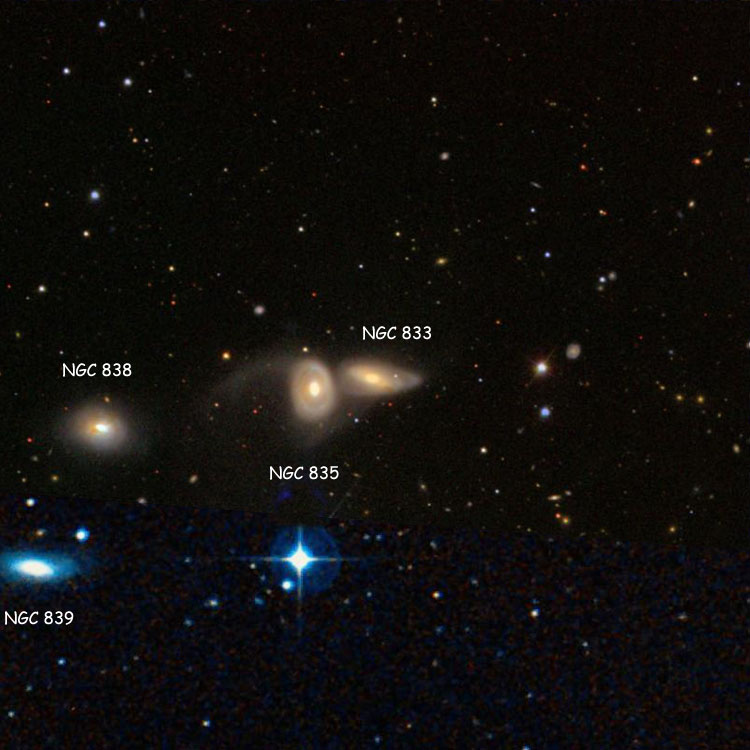
Above, a SDSS image overlaid on a 12 arcmin wide DSS image centered on NGC 833
Also shown are NGC 835, 838 and 839
Below, a 4 by 3 arcmin wide SDSS image of NGC 833 and 835, emphasizing their faint outer regions
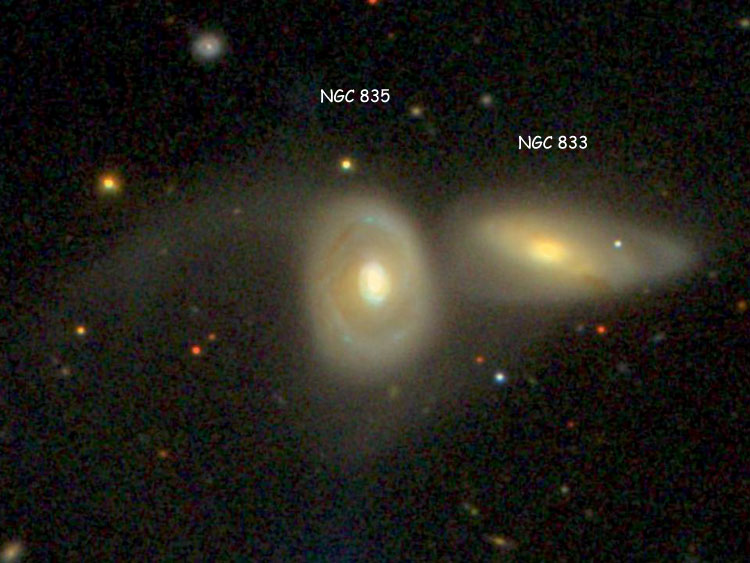
Below, a 1.6 arcmin wide SDSS image of NGC 833, also showing part of NGC 835
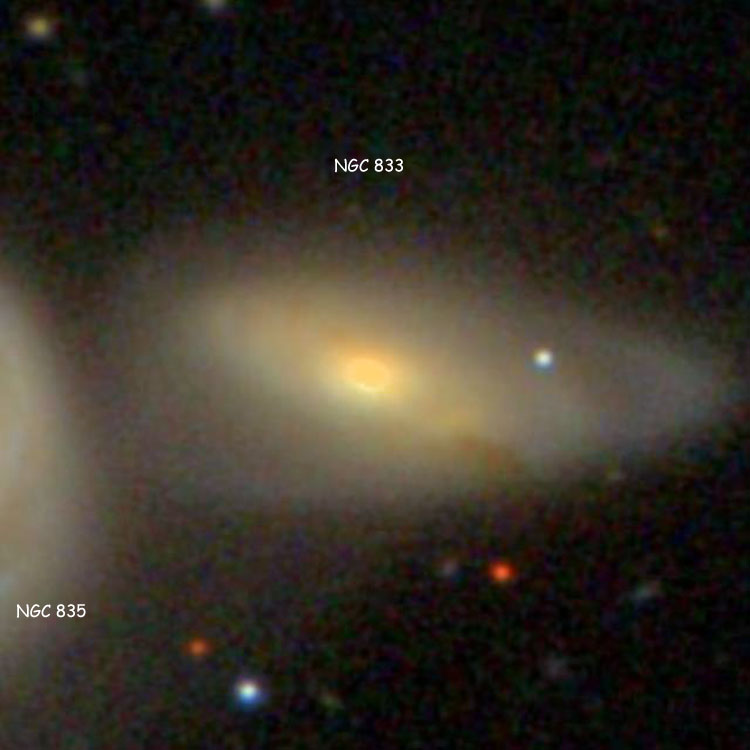
Below, a SDSS image overlaid on a 6 arcmin wide DSS image centered on Arp 318

NGC 834 (= PGC 8352)
Discovered (Sep 21, 1786) by William Herschel
A 13th-magnitude spiral galaxy (type Sbc?) in Andromeda (RA 02 11 01.3, Dec +37 40 00)
Historical Identification: Per Dreyer, NGC 834 (= GC 496 = WH III 567, 1860 RA 02 02 32, NPD 53 00.7) is "very faint, small, a little extended". The position precesses to RA 02 10 57.2, Dec +37 39 06, less than an arcmin southwest of the galaxy, so the identification is certain.
Physical Information: Apparent size 1.05 by 0.5 arcmin (from images below)

Above, a 12 arcmin wide DSS image centered on NGC 834
Below, a 1.2 arcmin wide DSS image of the galaxy
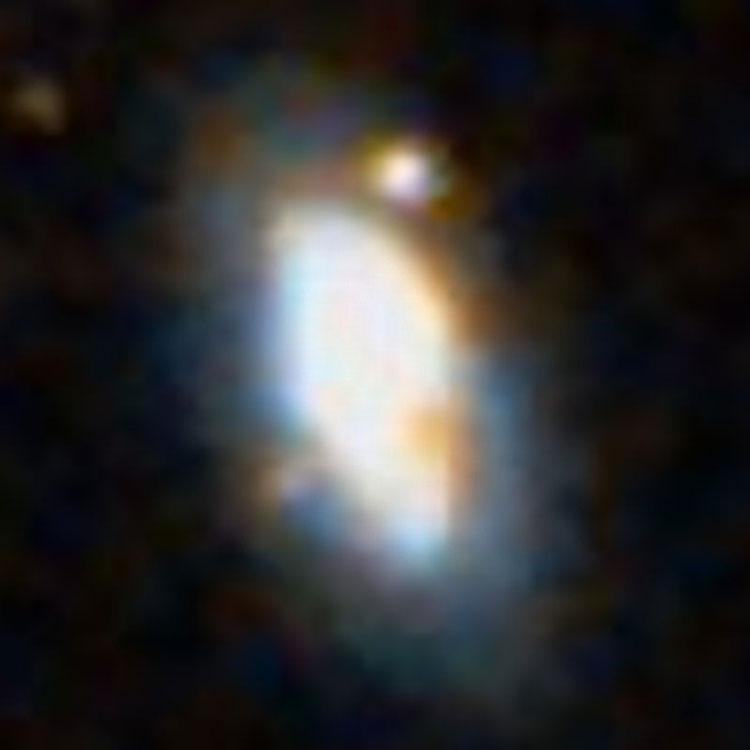
NGC 835 (= PGC 8228 = HCG 16A,
and with NGC 833, 838 and 839 = Arp 318 = Hickson Compact Group 16)
Discovered (Nov 28, 1785) by William Herschel
Also observed (date?) by John Herschel
A 12th-magnitude spiral galaxy (type SBab? pec) in Cetus (RA 02 09 24.6, Dec -10 08 09)
Historical Identification: Per Dreyer, NGC 835 (= GC 497 = JH 200 = JH 2464 = WH II 483, 1860 RA 02 02 33, NPD 100 47.8) is "faint, small, round, 2nd of 4", the others being NGC 833, 838 and 839
Physical Information: Apparent size 1.3 by 1.1 arcmin?

Above, a SDSS image overlaid on a 12 arcmin wide DSS image centered on NGC 835
Also shown are NGC 833, 838 and 839
Below, a 4 by 3 arcmin wide SDSS image of NGC 835 and 833, emphasizing their faint outer regions

Below, a 2.6 arcmin wide portion of the image above
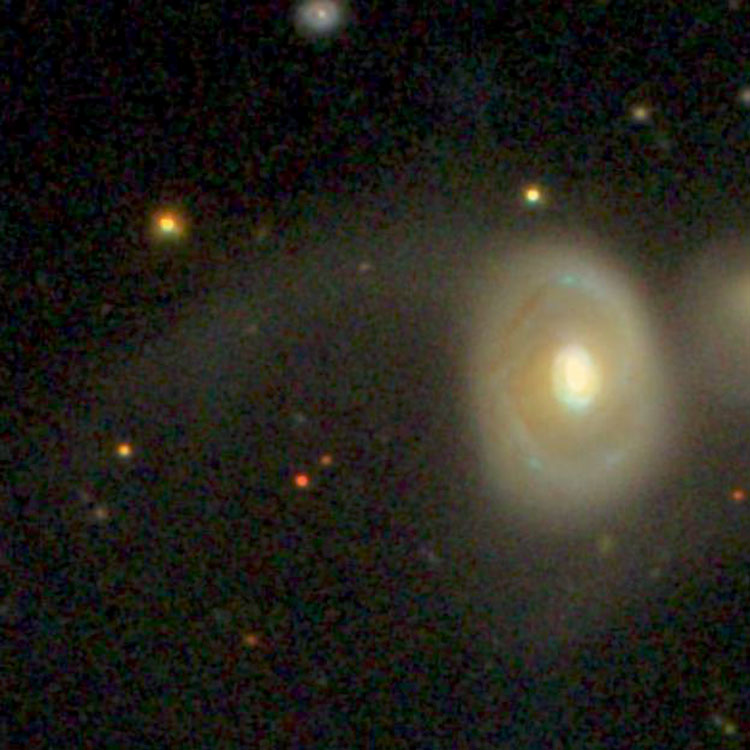
Below, a 1.4 arcmin wide SDSS image of the central part of NGC 835, also showing part of NGC 833

Below, a SDSS image overlaid on a 6 arcmin wide DSS image centered on Arp 318

NGC 836 (= PGC 8304)
Discovered (1886) by Frank Muller
Also observed (date?) by Herbert Howe
A 13th-magnitude lenticular galaxy (type S0/a?) in Cetus (RA 02 10 24.9, Dec -22 03 17)
Historical Identification: Per Dreyer, NGC 836 (Muller list II (#325), 1860 RA 02 02 36, NPD 112 43.6) is "extremely faint, small, round, gradually brighter middle and nucleus". The second Index Catalog lists a corrected 1860 RA (per Howe) of 02 03 55.
Physical Information: Apparent size 1.0 by 0.75 arcmin (from images below)

Above, a 12 arcmin wide DSS image centered on NGC 836
Below, a 1.25 arcmin wide DSS image of the galaxy
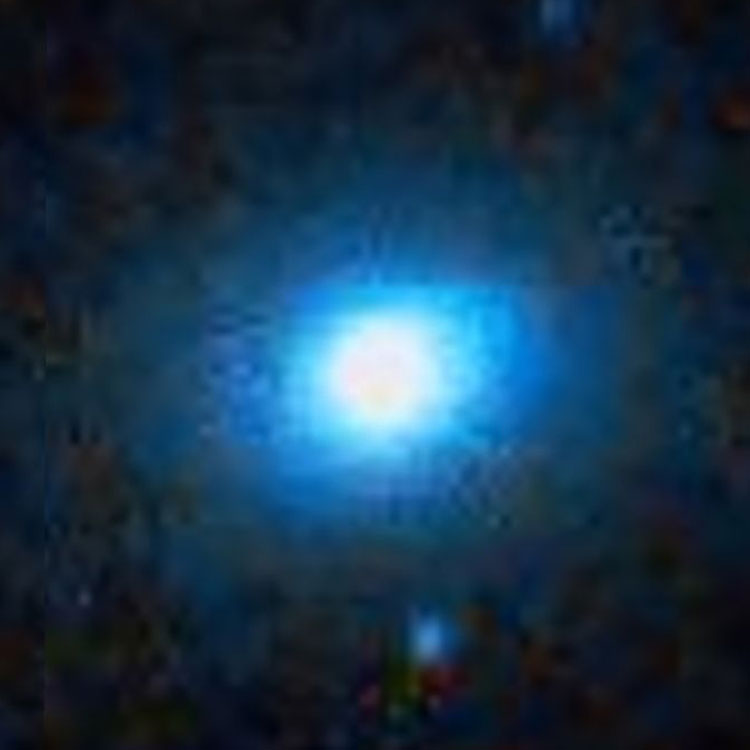
NGC 837 (= PGC 8297)
Discovered (1886) by Francis Leavenworth
Also observed (date?) by Herbert Howe
A 14th-magnitude spiral galaxy (type Sb?) in Cetus (RA 02 10 16.3, Dec -22 25 51)
Historical Identification: Per Dreyer, NGC 837 (Leavenworth list II (#326), 1860 RA 02 02 40, NPD 113 06.6) is "extremely faint, pretty small, much extended 0°, 10th magnitude star 1 arcmin to north". The second Index Catalog lists a corrected 1860 RA (per Howe) of 02 03 47.
Physical Information: Apparent size 0.9 by 0.35 arcmin (from images below)

Above, a 12 arcmin wide DSS image centered on NGC 837
Below, a 1.2 arcmin wide DSS image of the galaxy
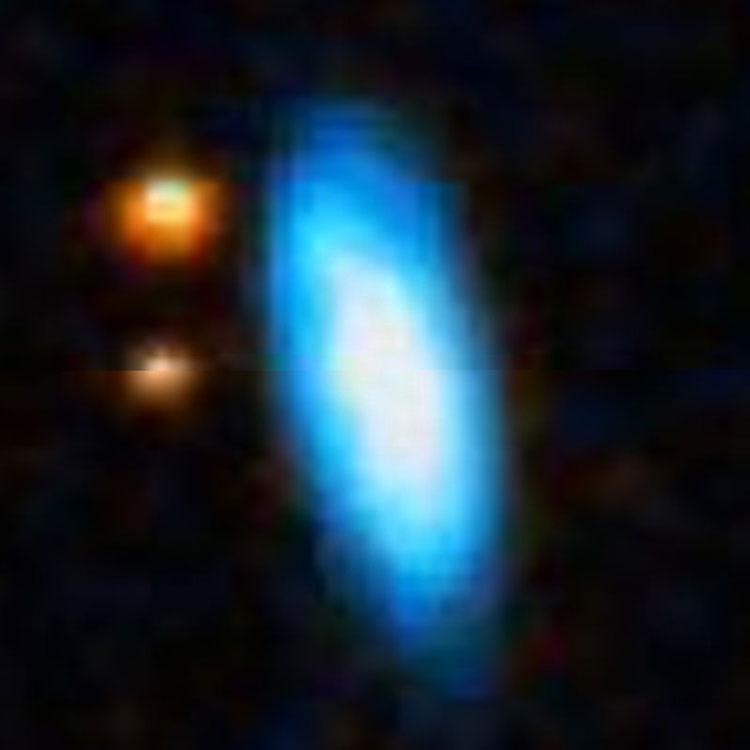
NGC 838 (= PGC 8250 = HCG 16C,
and with NGC 833, 835 and 839 = Arp 318 = Hickson Compact Group 16)
Discovered (Nov 28, 1785) by William Herschel
Also observed (date?) by John Herschel
A 13th-magnitude lenticular galaxy (type SA0(rs)a pec?) in Cetus (RA 02 09 38.5, Dec -10 08 45)
Historical Identification: Per Dreyer, NGC 838 (= GC 498 = JH 201 = JH 2465 = WH II 484, 1860 RA 02 02 47, NPD 100 48.5) is "very faint, very small, round, 3rd of 4", the others being NGC 833, 835 and 839.
Physical Information: Apparent size 1.2 by 0.8 arcmin (from images below)
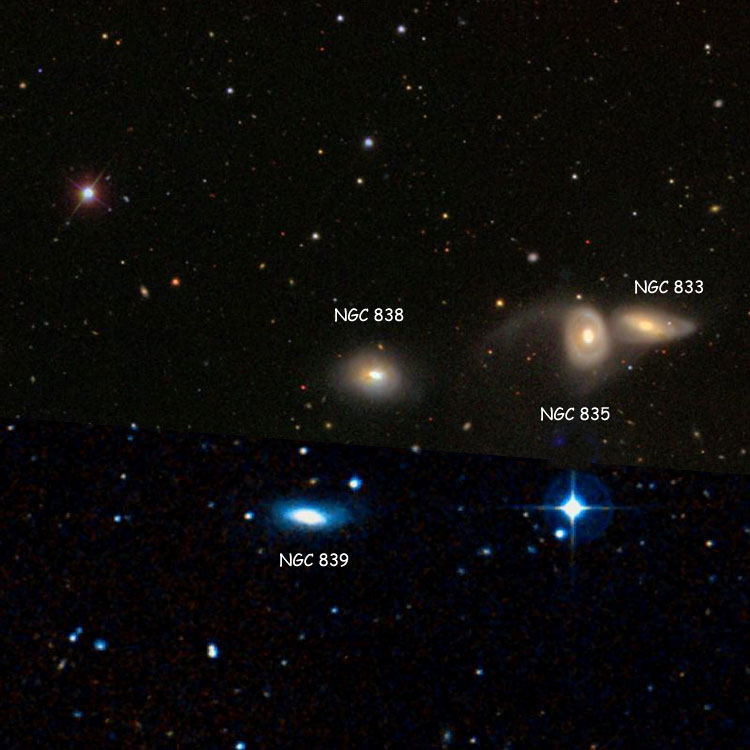
Above, a SDSS image overlaid on a 12 arcmin wide DSS image centered on NGC 838
Also shown NGC 833, 835 and 839
Below, a 1.4 arcmin wide SDSS image of the galaxy
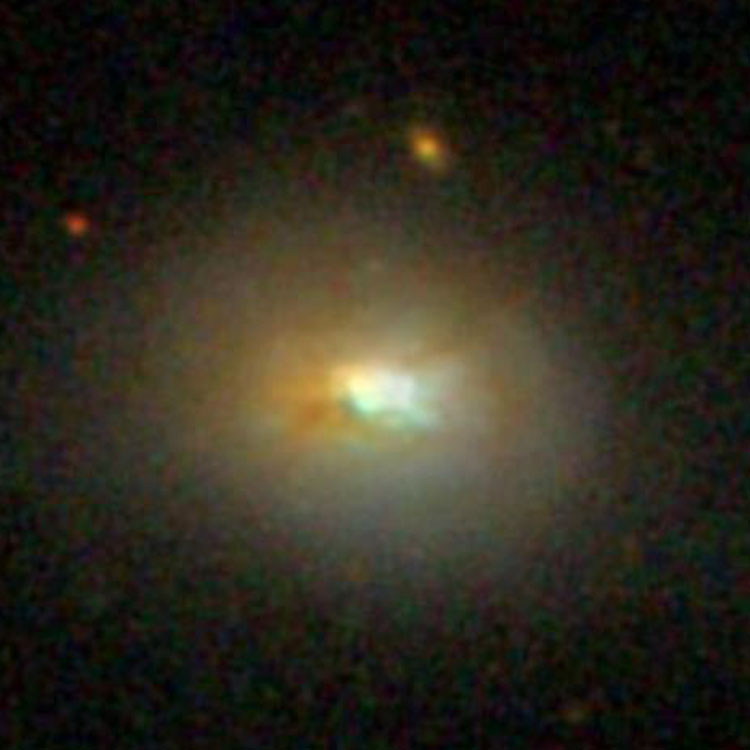
Below, a 0.95 arcmin wide HST image of the galaxy (Image Credit Hubble Legacy Archive, Courtney Seligman)
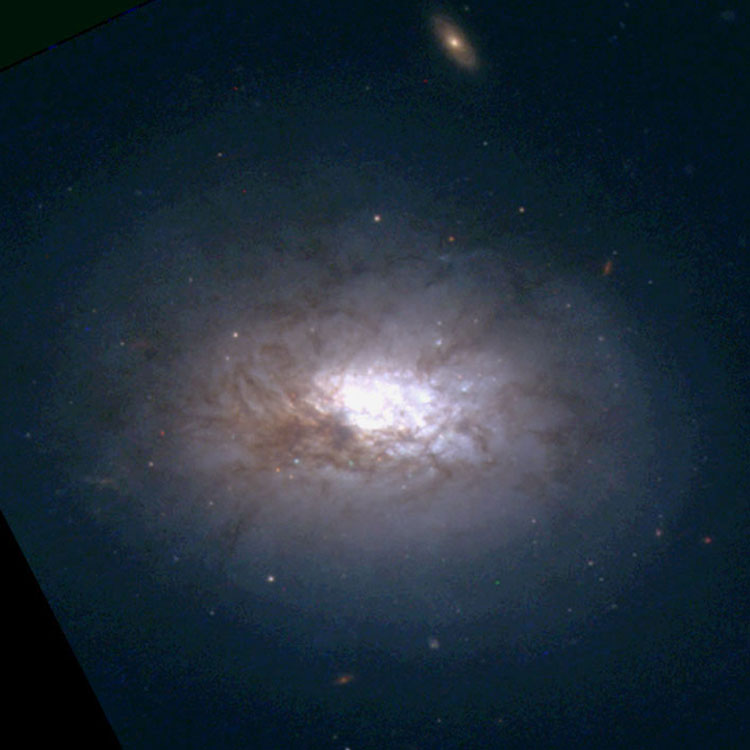
Below, a SDSS image overlaid on a 6 arcmin wide DSS image centered on Arp 318

NGC 839 (= PGC 8254 = HCG 16D,
and with NGC 833, 835 and 838 = Arp 318 = Hickson Compact Group 16)
Discovered (Nov 28, 1785) by William Herschel
Also observed (date?) by John Herschel
A 13th-magnitude lenticular galaxy (type S0?) in Cetus (RA 02 09 42.7, Dec -10 11 01)
Historical Identification: Per Dreyer, NGC 839 (= GC 499 = JH 202 = JH 2466 = WH II 485, 1860 RA 02 02 52, NPD 100 51.2) is "very faint, pretty small, 4th of 4", the others being NGC 833, 835 and 838.
Physical Information: Apparent size 1.35 by 0.5 arcmin (from images below)
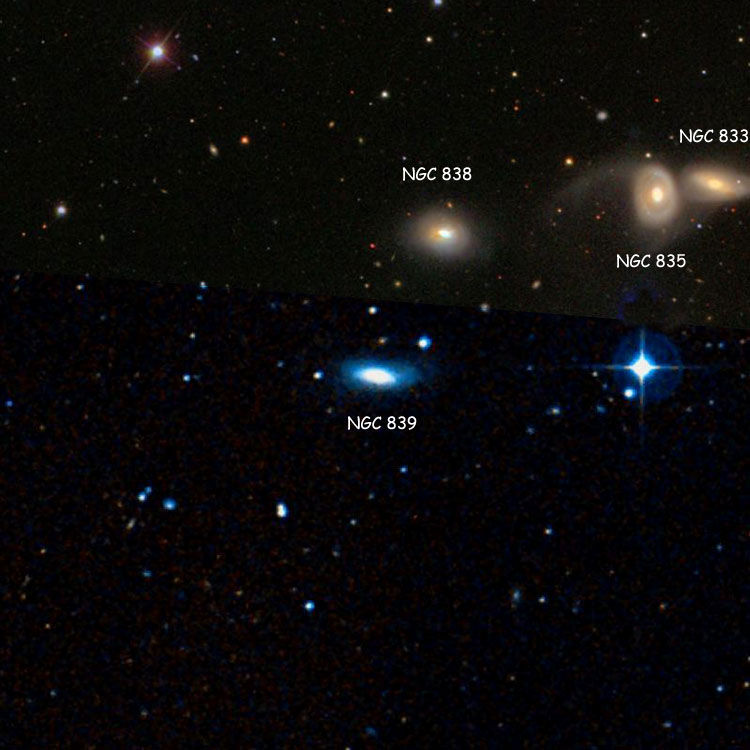
Above, a SDSS image overlaid on a 12 arcmin wide DSS image centered on NGC 839
Also shown NGC 833, 835 and 838
Below, a 1.6 arcmin wide DSS image of the galaxy

Below, a SDSS image overlaid on a 6 arcmin wide DSS image centered on Arp 318

NGC 840 (= PGC 8293)
Discovered (Sep 2, 1864) by Albert Marth
A 13th-magnitude spiral galaxy (type SBb?) in Cetus (RA 02 10 16.2, Dec +07 50 43)
Historical Identification: Per Dreyer, NGC 840 (= GC 5223, Marth #55, 1860 RA 02 02 52, NPD 82 49) is "extremely faint, very small".
Physical Information: Apparent size 1.8 by 1.0 arcmin?

Above, a 12 arcmin wide SDSS image centered on NGC 840
Below, a 2.4 arcmin wide SDSS image of the galaxy
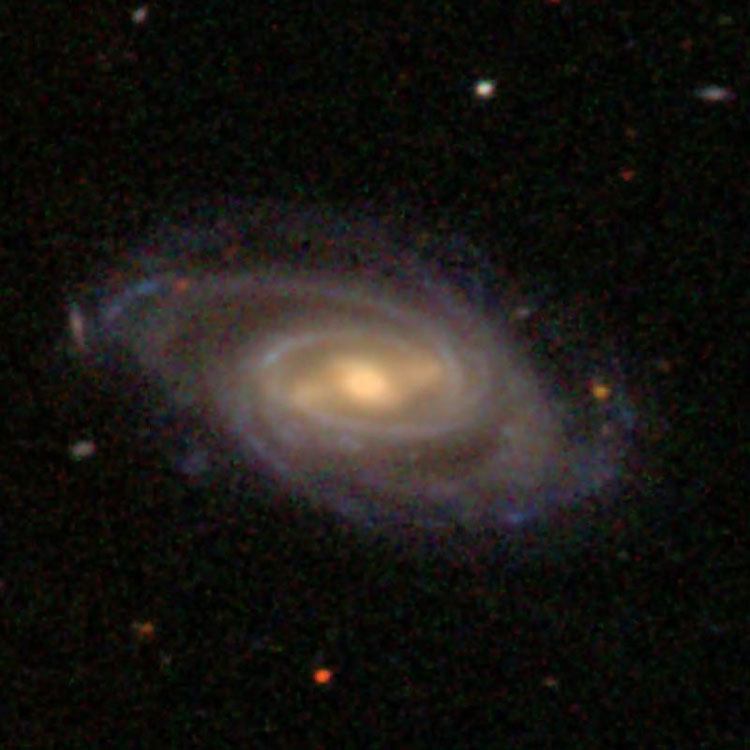
NGC 841 (= PGC 8372)
Discovered (Jan 17, 1787) by William Herschel
Also observed (date?) by Heinrich d'Arrest
Rediscovered (Nov 24, 1883) by Édouard Stephan
A 13th-magnitude spiral galaxy (type (R)SAB(s)ab?) in Andromeda (RA 02 11 17.4, Dec +37 29 50)
Historical Identification: Per Dreyer, NGC 841 (Stephan list XIII (#16), 1860 RA 02 02 52, NPD 53 10.0) is "pretty bright, very small, much brighter middle and nucleus equivalent to a 13th or 14th magnitude star". The position precesses to RA 02 11 16.9, Dec +37 29 46, right on the galaxy, so the identification is certain.
Discovery Notes: Although the identification is certain, the GC had an error that carried over to the NGC that confuses the discovery credits for NGC 841 and 845. William Herschel's WH III 604, which John Herschel thought was an earlier but incorrect observation of his JH 204 (= GC 501 = NGC 845), was actually an observation of NGC 841, and d'Arrest's supposed confirmation of those observations was also for NGC 841. So the NGC entry for NGC 841, "Stephan list XIII (#16)", should have read "WH III 604, d'Arrest, Stephan list XIII (#16)", and William Herschel was the original discoverer, not Stephan. However, when Stephan observed the region he used the GC (as most observers of the day would have) to compare his observations of the region to those of previous observers, and in that catalog the only suggestion that there might be a problem with the region is a note for GC 501 stating "C.H. (Caroline Herschel) and Auwers make the R.A. 1m less". If he'd thought about it, Stephan might have surmised that his observation of a nebula 1m to the west of GC 501 represented a duplication of a possible observation of the same nebula by William Herschel (as turned out to be the case), but since John Herschel thought the 1m difference was simply an error in previous observations of his JH 204, Stephan would have no reason to think otherwise. So he presumed he had found a new nebula, Dreyer agreed, and Stephan was given credit for discovering an object that William Herschel had already discovered. Stephan does deserve credit for rediscovering NGC 841, and being the first to notice that there were three nebulae in the region (now listed as NGC 834, 841 and 845). He just wasn't the first to observe any one of them. (Note: The history presented above is based on Corwin's notes; but since it is not presented in the same way, it did not seem appropriate to simply say "per Corwin".)
Physical Information: Based on a recessional velocity of 4540 km/sec, NGC 841 is about 210 million light years away, in good agreement with redshift-independent distance estimates of 160 - 215 million light years. Given that and its apparent size of 1.8 by 1.0 arcmin(?), it is about 110 thousand light years across.

Above, a 12 arcmin wide DSS image centered on NGC 841
Below, a 2.4 arcmin wide DSS image of the galaxy,br>
NGC 842 (= PGC 8258)
Discovered (Jan 8, 1831) by John Herschel
A 13th-magnitude lenticular galaxy (type S0?) in Cetus (RA 02 09 50.8, Dec -07 45 45)
Historical Identification: Per Dreyer, NGC 842 (= GC 500 = JH 203, 1860 RA 02 02 55, NPD 98 25.1) is "very faint, very small, round, pretty suddenly bright middle, the 3rd of 3", the others being NGC 829 and 830. The position precesses to RA 02 09 52.3, Dec -07 45 15, which is less than an arcmin northwest of the galaxy, so the identification is certain.
Physical Information: Apparent size 1.6 by 0.9 arcmin (from images below)
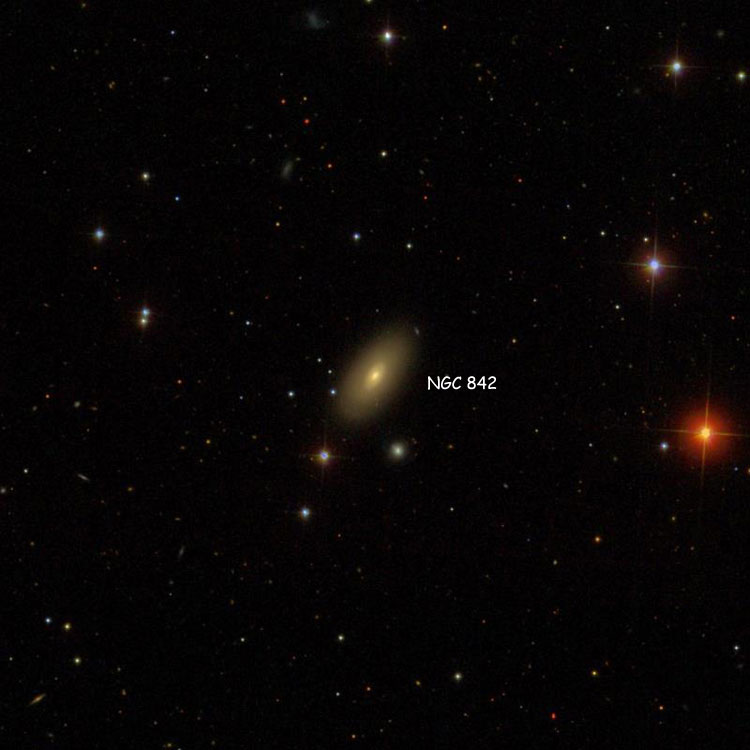
Above, a 12 arcmin wide SDSS image centered on NGC 842
Below, a 1.8 arcmin wide SDSS image of the galaxy

NGC 843
Recorded (Sep 16, 1865) by Heinrich d'Arrest
Three stars in Triangulum (RA 02 11 08.1, Dec +32 05 49)
Historical Identification: Per Dreyer, NGC 843 (= GC 5224, d'Arrest, 1860 RA 02 02 56, NPD 58 34.0) is "a globular cluster, faint, small, round". The position precesses to RA 02 11 07.2, Dec +32 05 46, very close to a triple star that could look like a very small cluster under less than ideal observing conditions, so the identification is considered certain.
Physical Information: Northern star (RA 02 11 08.4, Dec +32 05 57); southern star (RA 02 11 08.3, Dec +32 05 48); western star (RA 02 11 07.5, Dec +32 05 48)

Above, a 12 arcmin wide SDSS image centered on the three stars listed as NGC 843
NGC 844 (= PGC 8291)
Discovered (Nov 18, 1863) by Albert Marth
A 14th-magnitude compact galaxy (type SB(rs)c? pec) in Cetus (RA 02 10 14.2, Dec +06 02 59)
Historical Identification: Per Dreyer, NGC 844 (= GC 5225, Marth #56, 1860 RA 02 02 56, NPD 84 37) is "faint, small". The position precesses to RA 02 10 16.1, Dec +06 02 49, less than half an arcmin southeast of the galaxy, so the identification is certain.
Physical Information: Based on a recessional velocity of 4525 km/sec, NGC 844 is about 210 million light years away. Given that and its apparent size of 0.35 by 0.3 arcmin, it is about 20 to 25 thousand light years across. (Note: A Wikisky search for NGC 844 or PGC 8291 shows an unlabeled area west of the galaxy.)
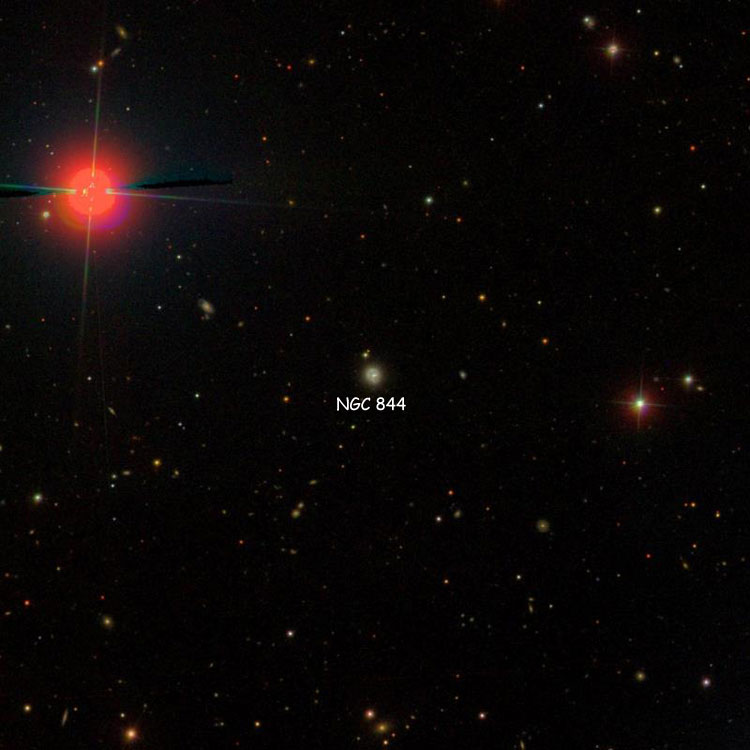
Below, a 0.6 arcmin wide SDSS image of the galaxy
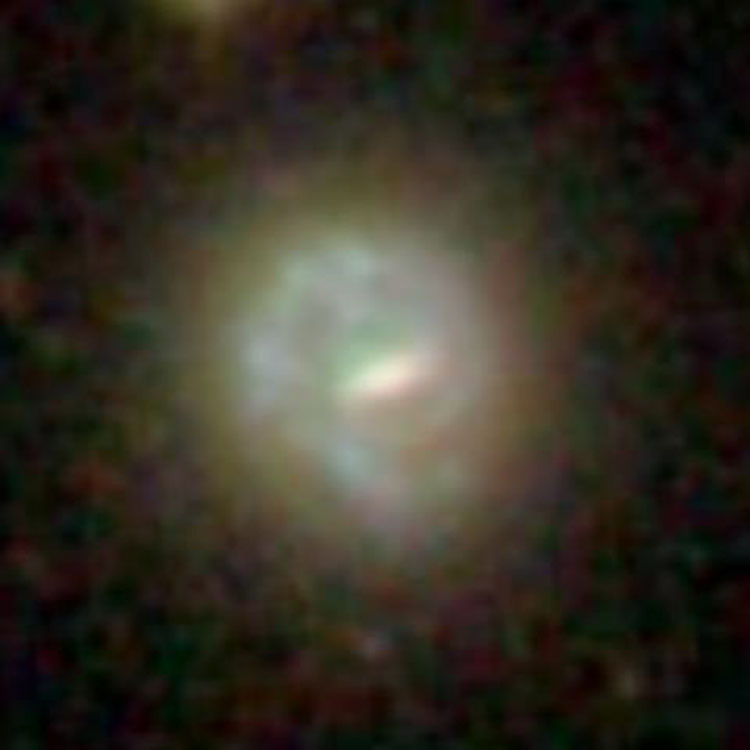
NGC 845 (= PGC 8438)
Not discovered by William Herschel
Discovered (October 1828) by John Herschel
Not observed by Heinrich d'Arrest
A 14th-magnitude spiral galaxy (type Sb?) in Andromeda (RA 02 12 19.8, Dec +37 28 39)
Historical Identification: Per Dreyer, NGC 845 (= GC 501 = JH 204 = WH III 604, d'Arrest, 1860 RA 02 03 05, NPD 53 10.5) is "very faint, irregular figure, stellar". The position precesses to RA 02 11 30.0, Dec +37 29 15, which is about 3 arcmin east of NGC 841, and there is nothing else nearby, so it would appear that NGC 845 is a duplication of NGC 841, and in one sense that is true, due to an error in the GC that carried over to the NGC. Namely, William Herschel's WH III 604, which John Herschel thought was an earlier but incorrect observation of his JH 204 (= GC 501 = NGC 845), was actually an observation of NGC 841, and d'Arrest's supposed confirmation of those observations was also for NGC 841. For whatever reason, Dreyer used d'Arrest's position for the listing for NGC 845. If that position had been accurate, it would have been the same as for NGC 841, in which case Dreyer might not have bothered with another entry; but it was a bit off, so he concluded that GC 501 was a different object, and assigned it a different listing. This means that two corrections should be applied to the listing for NGC 845. First, "GC 501 = WH III 604 = JH 204, d'Arrest" should be replaced by "GC 501 = JH 204", which means that William Herschel was not the discoverer as usually stated, but his son John. Second, the position should be changed to that observed by John Herschel, since all the other observations refer to NGC 841, not NGC 845. The position listed by John Herschel for GC 501 is 1860 RA 02 03 56.7, NPD 53 10 55.5, which precesses to RA 02 12 22.2, Dec +37 28 40, which is right on the galaxy listed above, and not only makes the identification certain, but proves that it is not a duplicate of NGC 841, after all. (Note: The history presented above is based on Corwin's notes; but since it is not presented in the same way, it did not seem appropriate to simply say "per Corwin".)
Physical Information: Based on a recessional velocity of 4430 km/sec, NGC 845 is about 205 million light years away, in good agreement with a single redshift-independent distance estimate of 215 million light years. Given that and its apparent size of 1.7 by 0.4 arcmin(?), it is about 100 thousand light years across.

Above, a 12 arcmin wide DSS image centered on NGC 845
Below, a 2.4 arcmin wide DSS image of the galaxy

NGC 846 (= NGC 847 = PGC 8430)
Discovered (Nov 22, 1876) by Édouard Stephan (and later listed as NGC 846)
Discovered (Nov 30, 1885) by Lewis Swift (and later listed as NGC 847)
A 12th-magnitude spiral galaxy (type SB(rs)ab?) in Andromeda (RA 02 12 12.3, Dec +44 34 07)
Historical Identification: Per Dreyer, NGC 846 (= GC 5226, Stephan list VIII (#4), 1860 RA 02 03 26, NPD 46 05.6) is "extremely faint, very small, round, gradually brighter middle". The position precesses to RA 02 12 12.7, Dec +44 34 05, right on the galaxy, so the identification is certain.
Physical Information: Based on a recessional velocity of 5120 km/sec, NGC 846 is about 235 to 240 million light years away. Given that and its apparent size of 1.9 by 1.7 arcmin(?), it is about 130 thousand light years across.
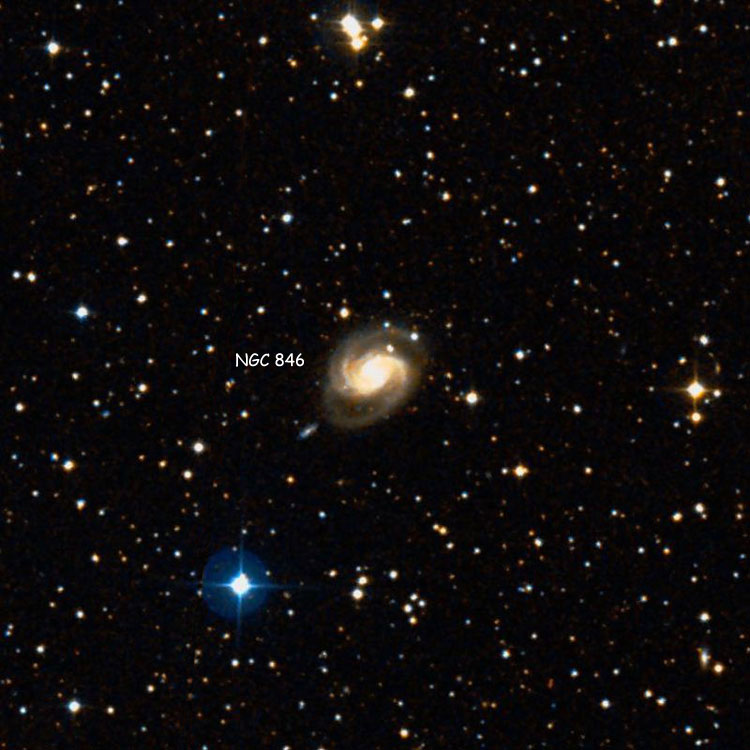
Above, a 12 arcmin wide DSS image centered on NGC 846
Below, a 2.4 arcmin wide DSS image of the galaxy
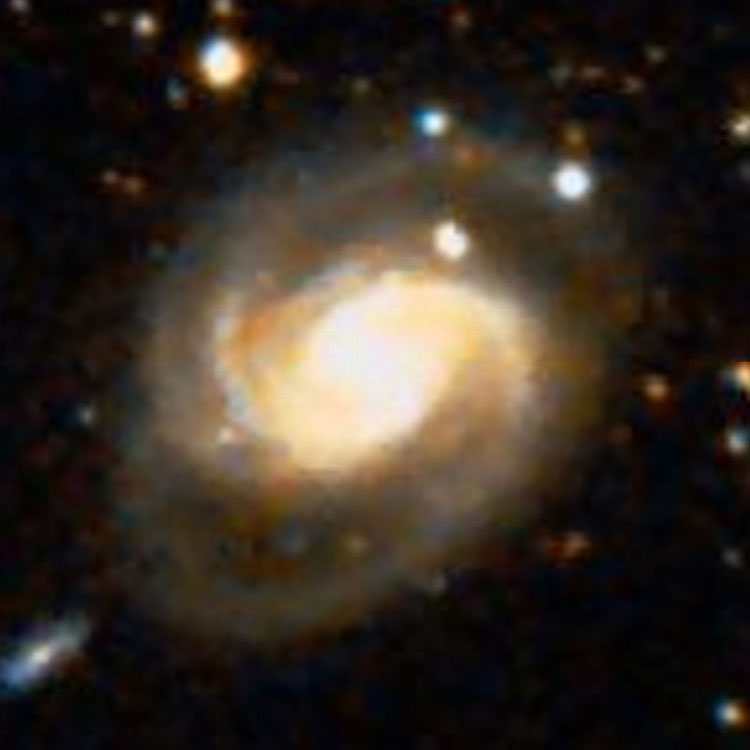
NGC 847 (= NGC 846 = PGC 8430)
Discovered (Nov 22, 1876) by Édouard Stephan (and later listed as NGC 846)
Discovered (Nov 30, 1885) by Lewis Swift (and later listed as NGC 847)
A 12th-magnitude spiral galaxy (type SB(rs)ab?) in Andromeda (RA 02 12 12.3, Dec +44 34 07)
Historical Identification: Per Dreyer, NGC 847 (Swift list III (#9), 1860 RA 02 03 33, NPD 46 04.9) is "very faint, pretty large, round". The position precesses to RA 02 12 19.8, Dec +44 34 47, just northeast of a relatively bright galaxy, so the identification is certain; the only problem is, the galaxy is the same one listed as NGC 846, so NGC 847 is a repetition of that entry. The duplication was noticed by Spitaler soon after the publication of the NGC, as is stated in the first Index Catalog.
Physical Information: Given the duplicate entry, see NGC 846 for anything else.
NGC 848 (= PGC 8299)
Discovered (Dec 11, 1885) by Ormond Stone
Independently discovered (Nov 1, 1886) by Lewis Swift
A 13th-magnitude spiral galaxy (type SBab?) in Cetus (RA 02 10 17.5, Dec -10 19 15)
Historical Identification: Per Dreyer, NGC 848 (Swift list V (#21), Ormond Stone list I (#49), 1860 RA 02 03 41, NPD 100 59.0) is "most extremely faint, pretty large, very difficult, star to northeast". (Swift's paper states (for his #21) "495-7-8-9 in field", meaning GC 495, 497, 498 and 499, which are NGC 833, 835, 838 and 839, Swift's field of view being so large that the other galaxies were within his field even though lying well to the northwest.)
Physical Information: Apparent size 1.5 by 1.0 arcmin?
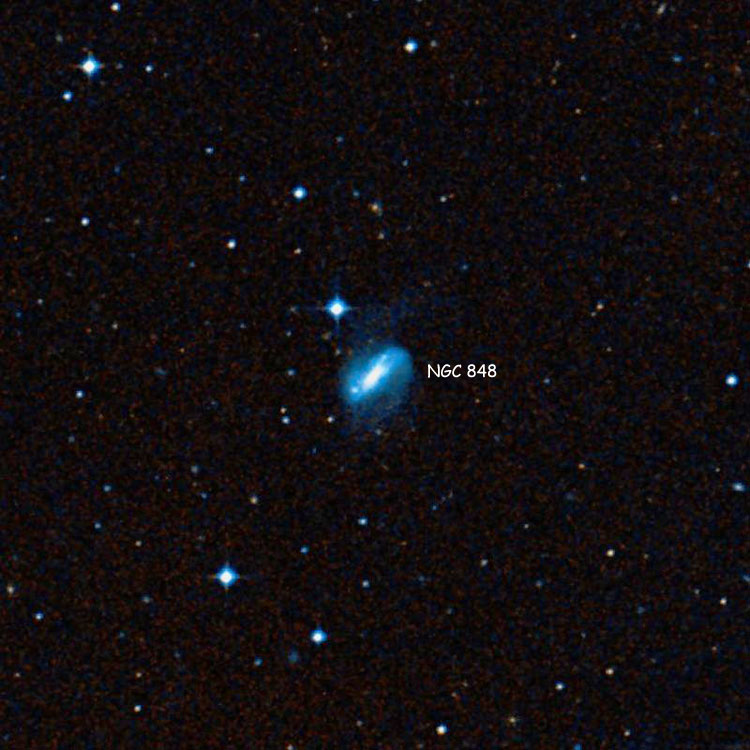
Above, a 12 arcmin wide DSS image centered on NGC 848
Below, a 2.4 arcmin wide DSS image of the galaxy
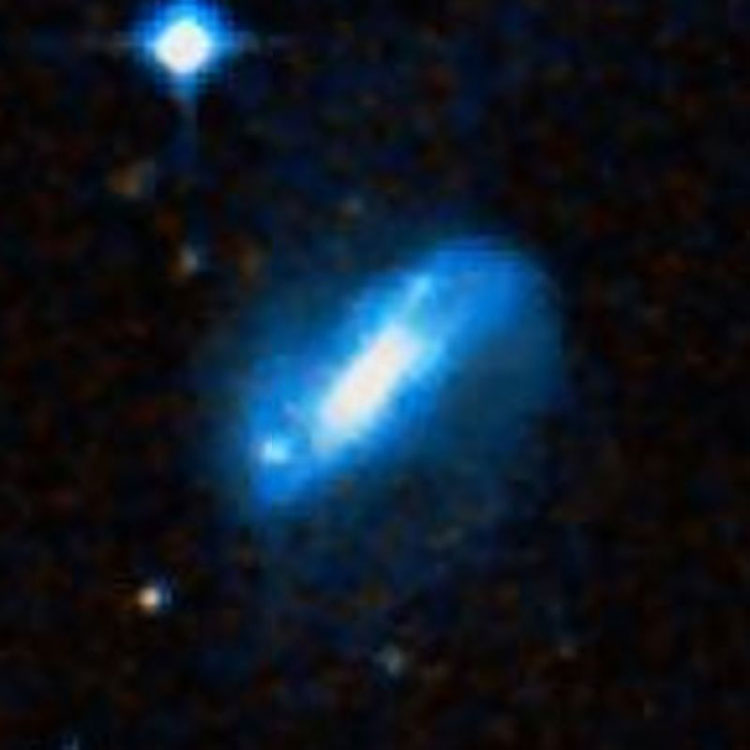
Below, an 18 arcmin wide SDSS/DSS composite image showing the galaxies noted by Swift in his note
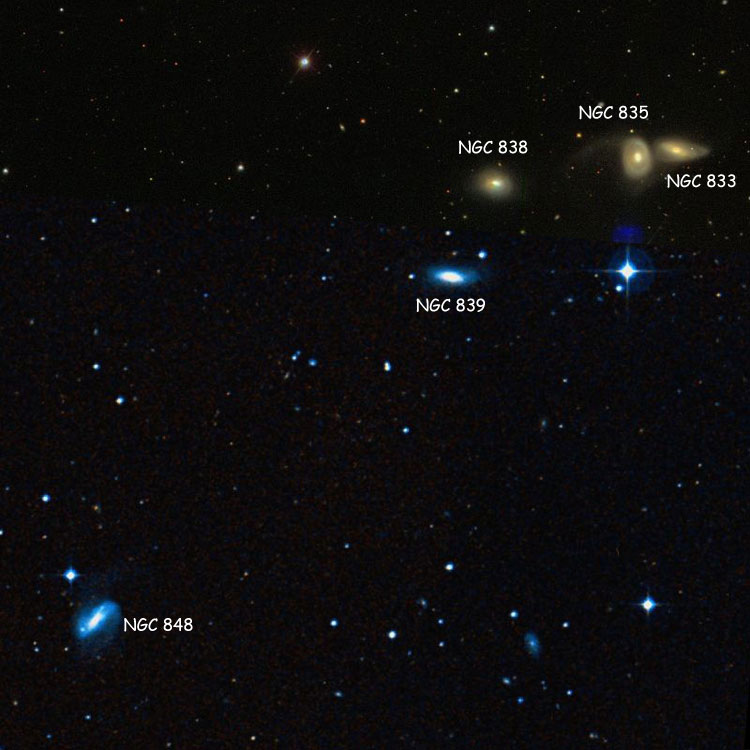
NGC 849 (= PGC 8286)
Discovered (1886) by Francis Leavenworth
A 14th-magnitude lenticular galaxy (type S0?) in Cetus (RA 02 10 11.2, Dec -22 19 23)
Historical Identification: Per Dreyer, NGC 849 (Leavenworth list II (#327), 1860 RA 02 03 43, NPD 113 00.6) is "extremely faint, very small, round (nebulous?)". The position precesses to RA 02 10 12.1, Dec -22 20 49, about an arcmin and a half south of the galaxy; but there is nothing else nearby and the description fits, so the identification is certain.
Physical Information: Apparent size 0.5 by 0.4 arcmin (from the images below)

Above, a 12 arcmin wide DSS image centered on NGC 849
Below, a 0.75 arcmin wide DSS image of the galaxy
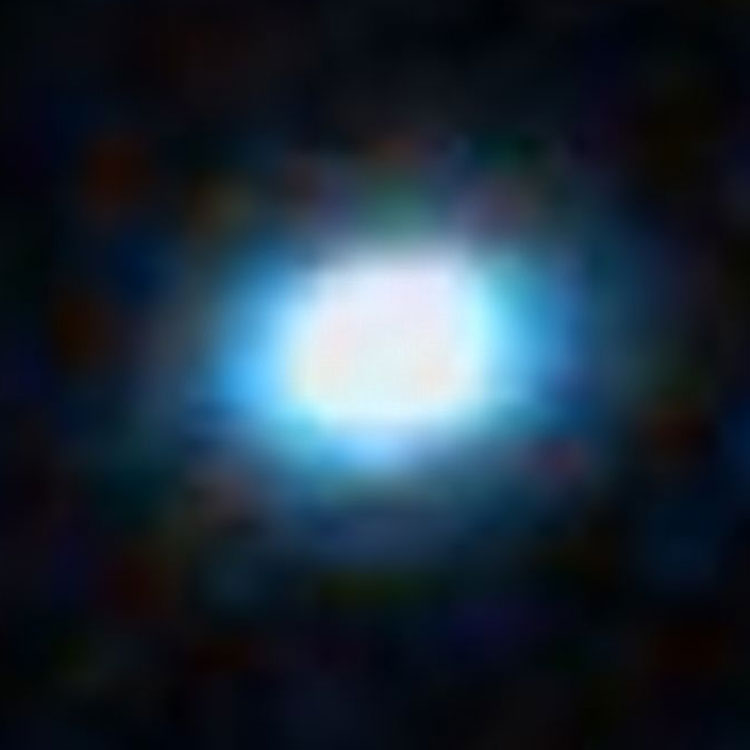
|